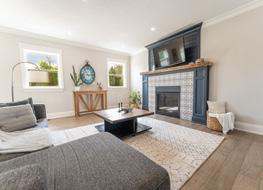










Marvin Canada takes pride in making a difference in the lives of Canadian homeowners. In fact, we’ve provided over millions of windows and doors for homes and businesses in Canada over the last 36 years.
































Marvin Canada takes pride in making a difference in the lives of Canadian homeowners. In fact, we’ve provided over millions of windows and doors for homes and businesses in Canada over the last 36 years.





















Earlier this winter, I had a looming deadline on an article for this very issue. The weekend was approaching and I had given myself until Monday to complete a first draft. My deadline happened to coincide with a snowstorm that forecasters warned could bring with it more than two feet of snow. Like many, I made a frenzied trip to the store to stock up on milk, eggs, snacks (and wine). While running errands, I noticed that anticipation of the first major snowfall had a polarizing effect on people— some were giddy with excitement while others mumbled expletives and pulled their coats tighter against the cold.
Back home, settled again at my desk, I stared at my empty screen and tried to summon inspiration. Gazing through the window, the street was bare—the snow still hadn’t started. Maybe the meteorologists were wrong, I thought. Maybe no storm was coming, and we’d all been running around for nothing.
Finally, tiny bits of snow began swirling and dancing. Moments later, flakes the size of toonies were ascending in a torrent, so thick I couldn’t see my car in the driveway. What a relief, I thought. Snow day
In the stillness that followed, my creative juices began to flow. I managed to pen a passable first draft by midmorning on Sunday, leaving the rest of the afternoon for Nordic skiing, snowman making and walking the dog through the drifts of white.

For some, just learning to embrace winter might take a bit of creative inspiration. And if you fall into that camp, you’ve come to the right place; this issue celebrates countless activities that the snowy season affords us. Perhaps you’re the type of person who would rather stay cozy—in that case, we have a little something for you too. After all, the lazy hours after a snowfall can feel like a gift—one that relieves us of the pressure to be productive.
As I type this letter, our talented team at Escarpment is in the final frantic hours before sending our files to press. We’re busy reading proofs and making last-minute changes, so that when more flakes start to fly, you’ll have all the inspiration you need in order to live your best season yet.
Winter comes but once a year— here’s to celebrating snow days on the Escarpment!
On the cover, detail of Weathered Tree Stump Overlooking Wintering Cottontail Rabbit by Harvey Bodach, acrylic on Masonite, 24" x 16".
Of course, the falling snow hadn’t changed my circumstances— I still had to write the editorial. But the world felt quieter than it had before. Relaxed yet full of possibility.




PUBLISHER/OWNER
Clay Dolan clay@escarpmentmagazine.ca
EDITOR- IN - CHIEF Cara Williams cara@escarpmentmagazine.ca
CREATIVE DIRECTOR Susan Meingast creative@escarpmentmagazine.ca
Mark Berens, Cale Best, Harvey Bodach, Giovanni Boni, Robert Burnaccioni, Malcolm Carmichael, Craig Cosby, Briley Cosgrove, Dana Cowie, Janet Dawson, Deena Dolan, Charles Fraresso, Andrew Forget, Caroline Gauthier, Lisa Hannaford, Marc Huminilowycz, Sue Kolundzic, Anton Kulyk, Matthew Lidbetter, Blair Locke, Kate MacLennan, Marcia Masino, Gary McGuffin, Fraser Penny, Andrew Peycha, Cameron T. Powell, Jo Redman, Leanne Scanlan, Taylor Savage, Kirsten Schollig, Jamie Smith, Ryan Sobkovich, Peter Taylor, William Tam, Desmond von Teichman, Jake Thomas, Jody Wilson, Kristie Woods, Shelby Worts, Micheal Yates, Jhi Yaemsuwan, Mark Zelinski

Escarpment® is published four times a year by Georgian Bay Living— Escarpment® Magazine Inc. 25,000 copies. Distributed free of charge to hotels, shops, clubs, businesses and services all throughout Simcoe, Grey & Bruce Counties.


Paid Subscription holders have guaranteed mail delivery. Attention Postmaster: Please direct post office returns and changes of address to GBL—Escarpment® Magazine Inc., 183 Marsh Street, Unit 4, PO Box 107, Clarksburg, ON, N0H 1J0
Subscription rates: 4 issues (one year), $14.50 HST incl. or 8 issues, (two years), $28.00 HST incl.

No part or portions of this publication may be reproduced without written permission of the Editor. Opinions and statements written by contributors of Escarpment® and that appear in this issue or others are entirely their own responsibility and do not necessarily reflect the opinions of the owner of GBL—Escarpment® Magazine Inc.
Georgian Bay Living—Escarpment Magazine® and Escarpment® is a registered trademark of Georgian Bay Living— Escarpment® Magazine Inc. ©2022 All rights reserved.
Escarpment is printed in a Canadian facility that operates in strict compliance to environmental concerns.
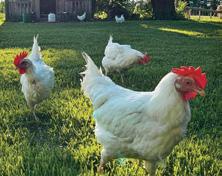
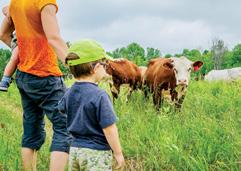

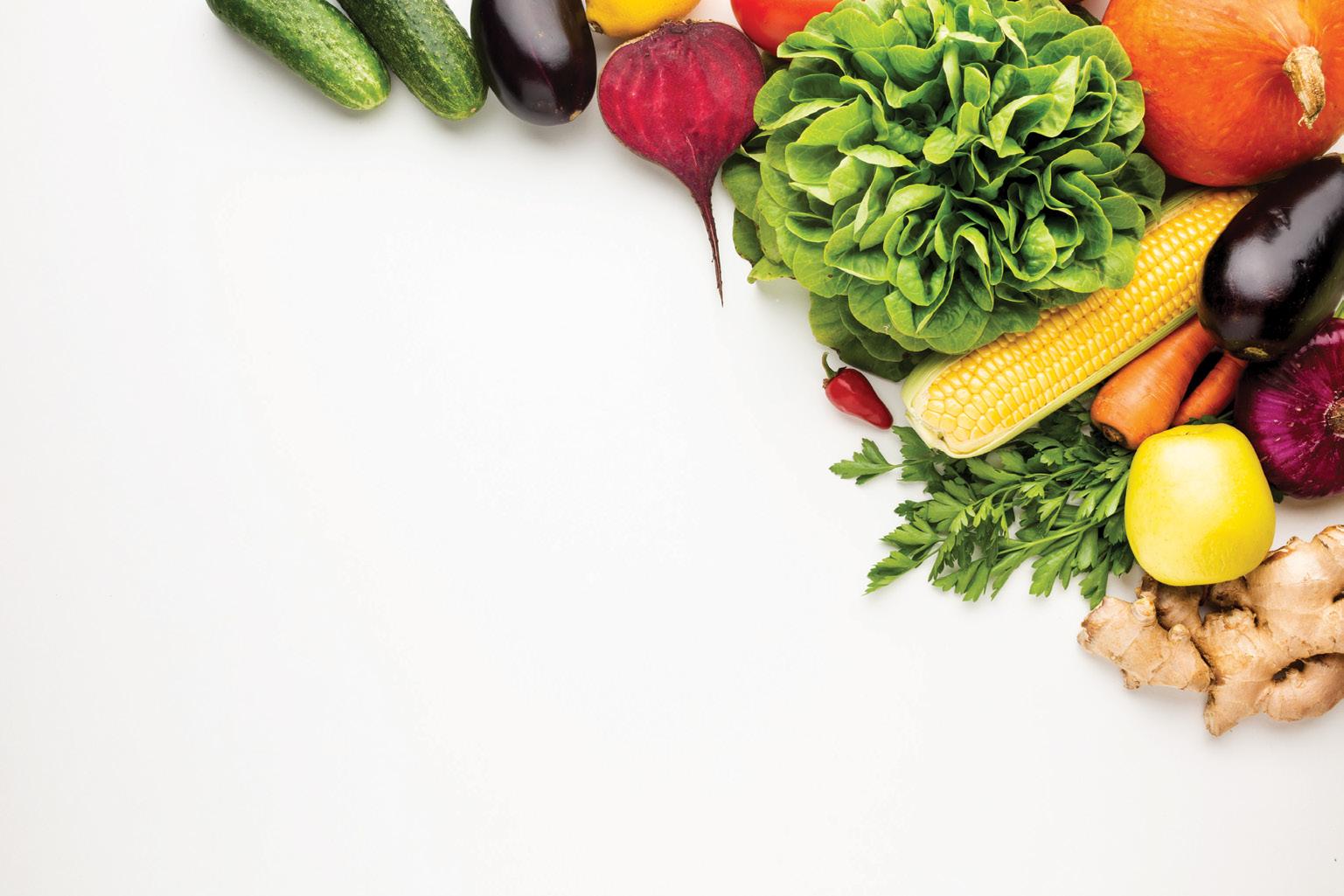
While some flock to warmer climes during the snowy season, the adventuresome souls who remain are rewarded with breathtaking views, unspoiled scenery, and wintry magic. Whether you want to drop a line into the frozen bay, explore your town or hike to an icy waterfall, Escarpment has something for everyone this winter.
Some hear the call year-round. For others, it comes when the first snowflakes fall. Yes, it’s cold and, yes, it will snow—but our winters provide a flurry of inspiring activities that are enhanced by heaping piles of lake effect snow.
The beauty of Georgian Bay and Lake Huron is perennial so, it’s fitting that the name Ontario is derived from the
by Cara WilliamsIndigenous word for “shimmering waters”. Surrounding our lakes and waterways are diverse and defining landscapes —from walking and hiking to fat-biking, snowshoeing, skating, Nordic skiing and ice fishing, we have everything that you would want in an outdoor winter excursion. Read on for a boundless assortment of adventures to get you outdoors and into the fresh air all season long.

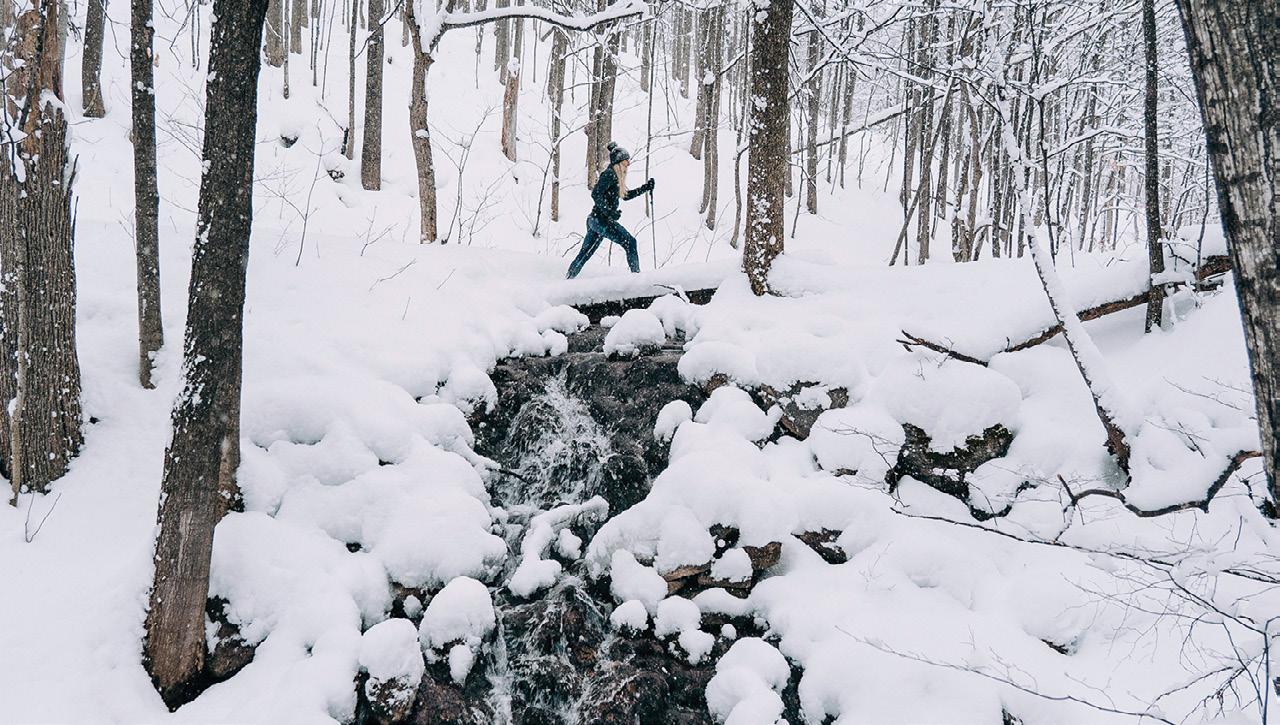
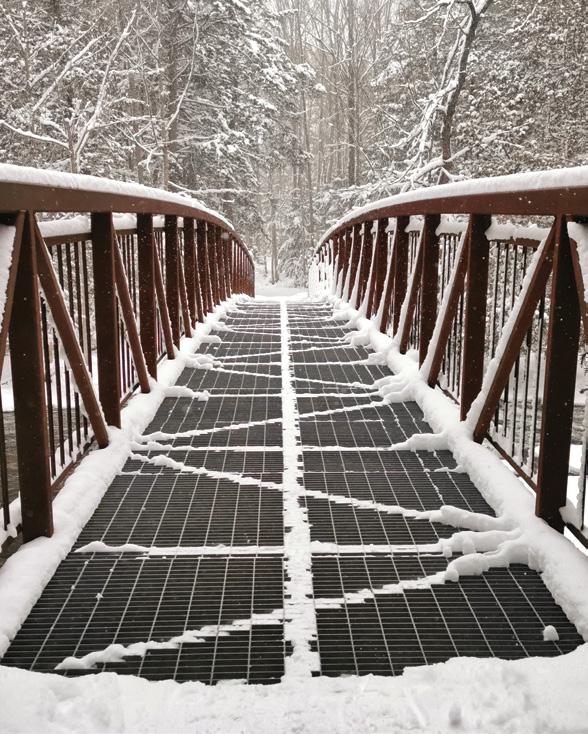
Georgian Bay’s turquoise waters are just as magical in the winter as they are in the summer, and with fewer people to contend with and no bugs, there are countless hiking routes to discover around Simcoe, Grey and Bruce. When in doubt, pick a section of the Bruce Trail. Get lost (but not too lost) exploring the trails at Lion’s Head and further north to Bruce Peninsula National Park. While The Grotto is perhaps the most popular natural attraction in the warmer months, you’ll likely have it all to yourself in the winter.
s
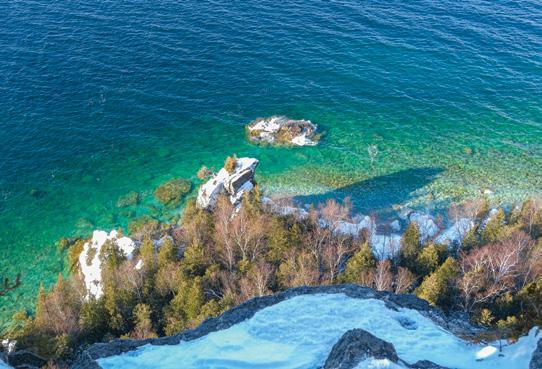

The jewel of Owen Sound, Harrison Park is accessible all winter and is popular for hiking, snowshoeing and cross-country skiing. The trail follows the Sydenham river south to the Freedom Trail, commemorating the first black settlers of Owen Sound, the northernmost stop on the Underground Railway. The Bruce Side Trail takes you over the Weaver Creek Boardwalk, an easy to navigate, 300-metre boardwalk that winds through the forest behind Harrison Park’s outdoor pool (closed in the winter).
If you’re into chasing frozen waterfalls, Hogg’s Falls is a mere two-minute walk from the Lower Valley Road near Flesherton. Named for William Hogg, the waters of the Boyne River tumble seven metres through the snow-covered woodland. Avid hikers can travel from Hogg’s Falls to Eugenia Falls or choose to loop the side trails, creating a 13-kilometre round trip.
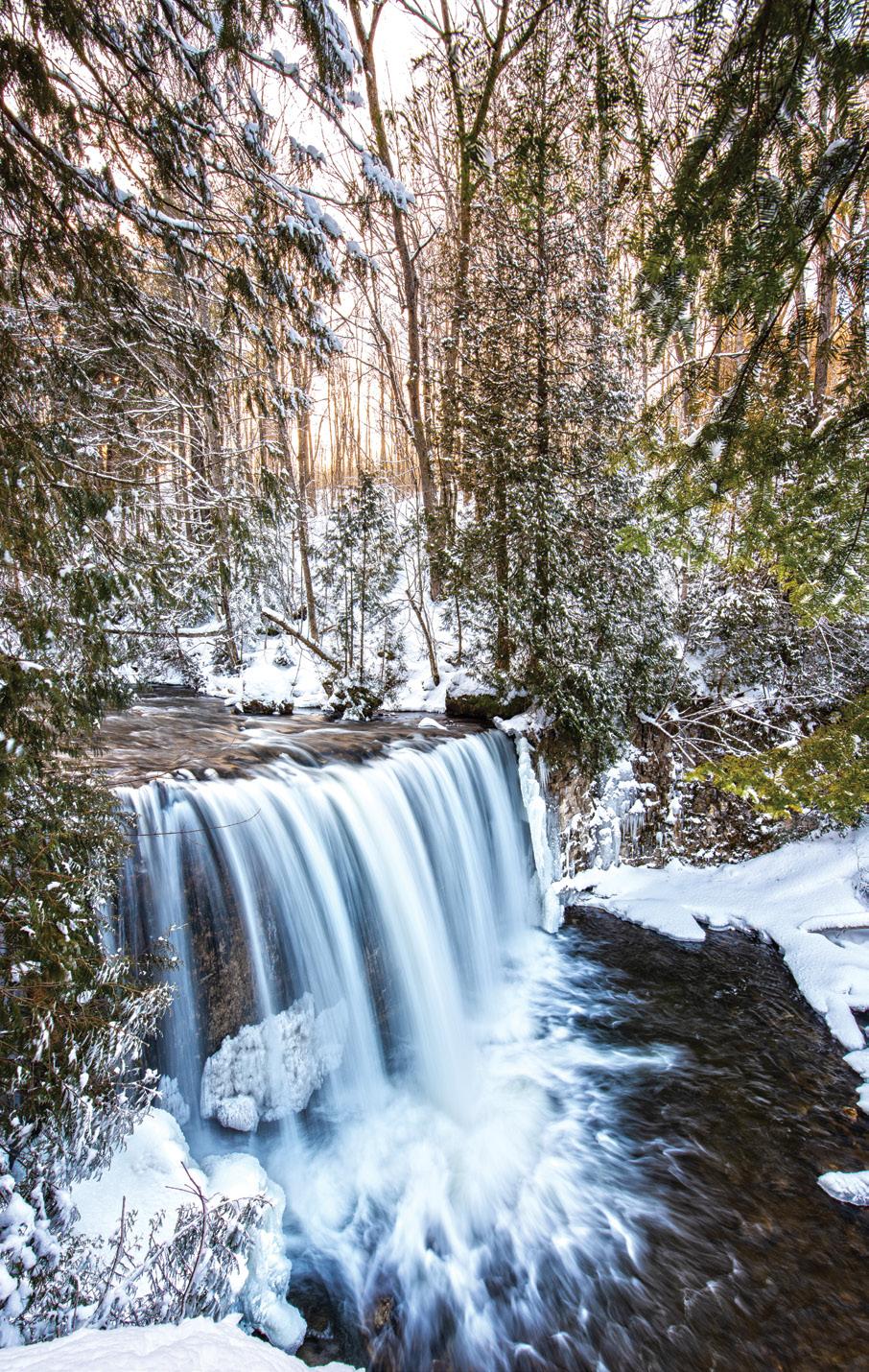
Further east, the Pretty River and Bruce Trail Loop is a moderately trafficked trail that offers stunning views of the Escarpment. A favourite among snowshoers, the Pretty River Valley Provincial Park trails take you to the highest point along the Bruce Trail. Know before you go—there is a one and half kilometre double track trail that is groomed in the winter by local snowmobile clubs.
Fresh snow adds to the beauty and serenity of winter hikes, and the brilliant ice formations along the Escarpment are incredible. While still gorgeous on a cloudy day, keep your fingers crossed for some sunshine and blue skies.
BY CLAY DOLANs

Popular beaches and bustling waterfronts transform into quiet places of respite in the snowy months. Blankets of fresh powder lay like quilts over the frozen lake, while layers of ice encase the rocks and shrubs along the shoreline. Dress warmly, take your time and enjoy beachcombing or birdwatching.

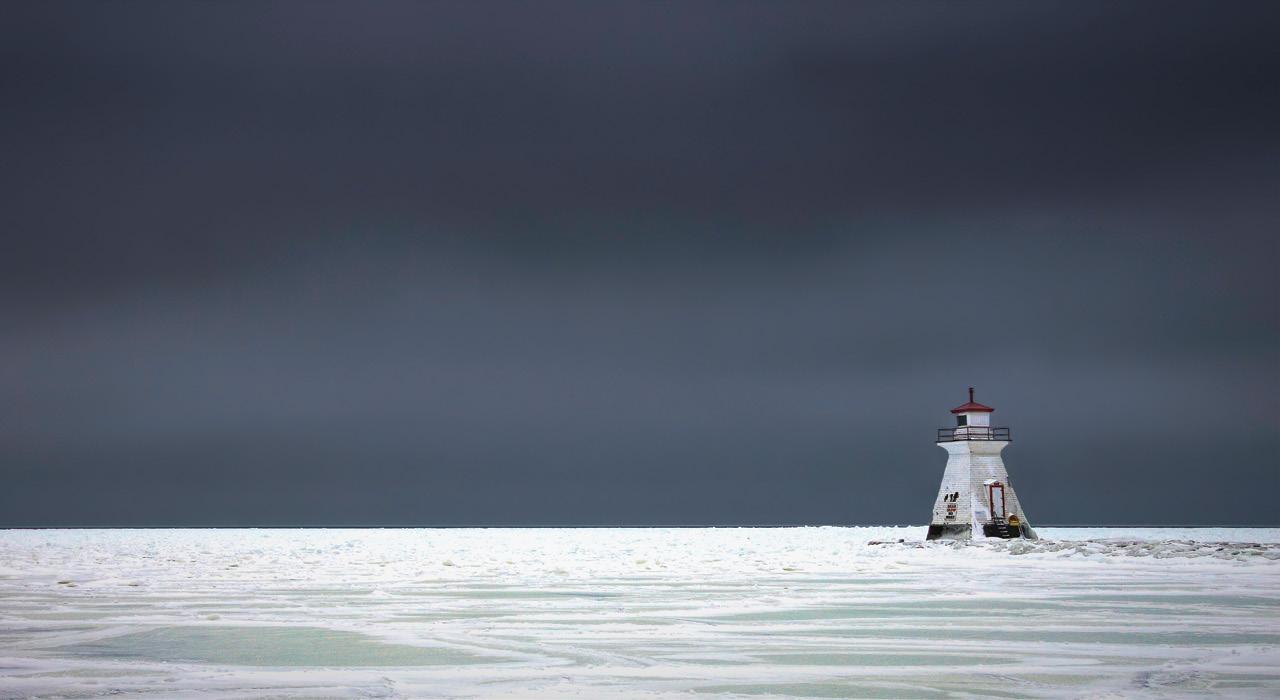
The Meaford Harbour dates back to the early 1830’s, when the first settlers arrived and named it Peggy’s Landing. Stunning in every season, the harbour is a magnet for amazing ice formations—it’s not uncommon for large slabs of ice to drift in from the eastern shorelines,

s


creating four to six-foot-tall turquoise ice walls on the bay. Pack a picnic and enjoy it on one of the harbourside benches.
Saugeen Shore’s North Shore Trail is a six kilometre multi-use trail connecting the towns of Port Elgin and Southampton. The trail weaves along the water’s edge, and includes a beautiful two kilometre section of beachfront boardwalk along Southampton’s shoreline. From here you can enjoy the view across to Chantry Island and its elegant Imperial Lighthouse. Head north and you’ll find yourself at Red Bay Beach Park,

near Oliphant. Bring your binoculars and keep an eye out for snow buntings, horned larks, and dark-eyed juncos. Snowy owls and great gray owls also make their way up the peninsula this time of year, as do flocks of wayward Canada geese on their migration journey.
Collingwood’s Harbour Circle Trail is about a four kilometre route along the waterfront and past the Arboretum and labyrinth. Follow the trail to Sunset Point and enjoy a stunning view of the town, the Collingwood Terminals, and the ski hills at Blue Mountain, Craigleith and Alpine.
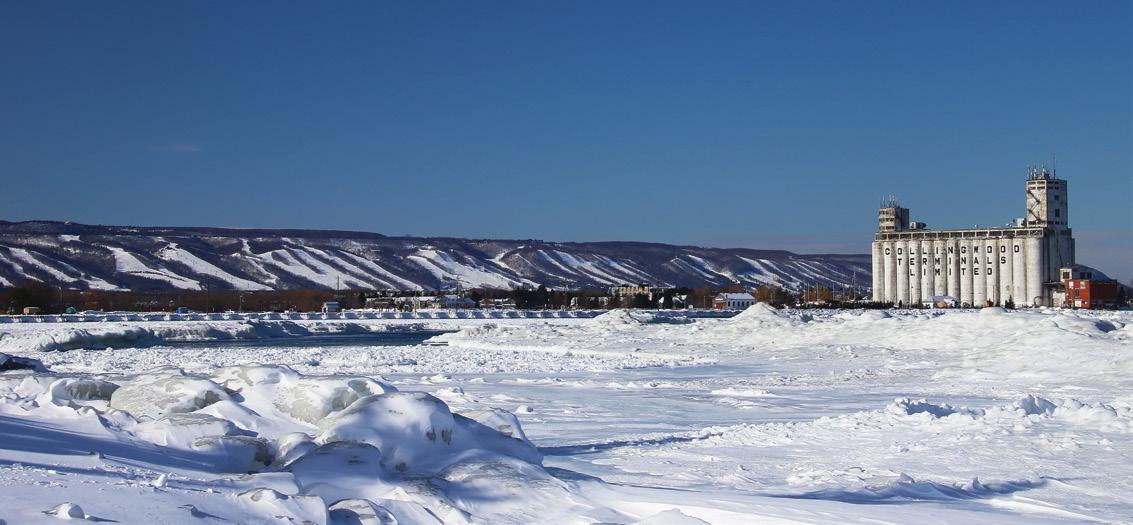
Nick Hamilton, CFP
Investment & Wealth Advisor
Hamilton Wealth Management 705-444-4777 nick.hamilton@rbc.com www.nicholashamilton.ca

RBC Dominion Securities
1 First St., Suite 230 Collingwood, ON
A financial advisor can bring you closer to the future you envision.
Advisors cultivate results over long time frames by harnessing expertise and resources across many different areas of the wealth spectrum.
We work with families, businesses and private investors to provide professional guidance on all financial matters.
We can assist with:
• Bespoke investment and wealth management strategies
• Ongoing financial education, context and support
• Detailed financial planning
• Tax minimization strategies
• Estate planning and Will reviews
Let’s explore how to better your financial future – together. Contact us today.
RBC Dominion Securities Inc.* and Royal Bank of Canada are separate corporate entities which are affiliated. *Member-Canadian Investor Protection Fund. RBC Dominion Securities Inc. is a member company of RBC Wealth Management, a business segment of Royal Bank of Canada. ® / ™ Trademark(s) of Royal Bank of Canada. Used under licence. ©2022 RBC Dominion Securities Inc. All rights reserved. 22_90544_FXV_003
A relationship with a financial advisor may be one of your best investments.RBC Dominion Securities Inc.
From toe-loops on backyard rinks to games of shinny on the lake or ponds, it doesn’t get more Canadian than outdoor skating. Similar to Blue Mountain’s Woodview Mountaintop Skating, MacGregor Point Provincial Park near Port Elgin has a 400-metre ice-skating trail that meanders through the lush forest. Both loops are lit at night for a magical winter skating experience.
Truly a four-season angling destination, some of the best ice fishing in the province can be found approximately three miles from the inner harbour of Owen Sound. Here, Lake Huron’s surface is transformed into a bustling community of colourful huts each winter, with anglers hoping to hook lake trout, whitefish, rainbow, walleyes, perch, browns and the odd coho king salmon.
It’s no secret that our area boasts incredible cross-country skiing—choose between a backcountry experience at Kolapore
 ICE FISHING, OWEN SOUND HARBOUR
PHOTO BY JAMIE SMITH
ICE FISHING, OWEN SOUND HARBOUR
PHOTO BY JAMIE SMITH
Glide along our 27 km of professionally groomed cross country ski trails, or hike 12 km of snowshoe trails through a majestic forest take in the spectacular views from Southern ontario’s longest Suspension Bridge or at Lookout Point
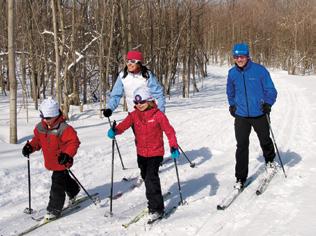

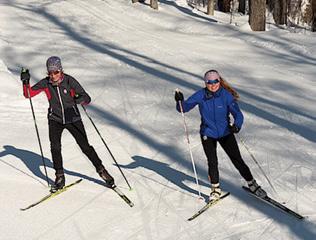

 FiNd YoUrSeLF iN NAtUre! Just a few minutes from collingwood, in one of canada’s 18 UNeSco biosphere reserves, are 370 unspoiled acres of mature hardwood forest We are here, atop the Niagara escarpment, where snowshoers and cross-country skiers alike will enjoy our breathtaking world of adventure in nature!
N o r d i c c e N t r e
FiNd YoUrSeLF iN NAtUre! Just a few minutes from collingwood, in one of canada’s 18 UNeSco biosphere reserves, are 370 unspoiled acres of mature hardwood forest We are here, atop the Niagara escarpment, where snowshoers and cross-country skiers alike will enjoy our breathtaking world of adventure in nature!
N o r d i c c e N t r e
Wilderness Trails or a family-friendly groomed trails at payand-play centres like Scenic Caves, Glenleg Nordic Club or Highlands Nordic. The Town of Blue Mountains grooms the multi-use Georgian Trail from Christie Beach Sideroad to Grey Road 21 throughout the winter season, and Wasaga Beach Provincial Park grooms 22 kilometres for classic skiing and 12 kilometres specifically for skate skiing.


One of the coolest (pun intended) winter sports, fat-biking has gained traction (yup, another pun) in the past few years. Collingwood’s multi-use trails system encompasses over 60 kilometres of recreational trails perfect for this growing sport. When perfectly packed, snow-covered trails can be every bit as fun as dirt, while offering a different experience. With tires
about twice as wide as a regular mountain bikes, fat-bikes provide more traction so they can travel over almost any surface. They even bounce over hard-crusted snow and plow through drifts of soft powder.
Perhaps the best thing about adventuring outside at this time of year, is there are often fewer people—providing a greater sense of quiet and solitude. The cool, clean air can also feel especially invigorating. When heading out on your next winter adventure, remember to dress for the weather and to check the forecast. If you are driving rural roads, be careful about where you pull over. Tire chains and a shovel are good items to pack, along with a sleeping bag, snacks and water just in case. Always make sure to top off your gas tank, as well.

















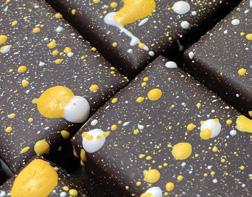



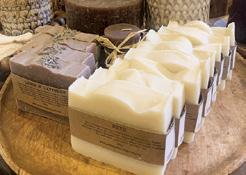















There’s no place like home—except, perhaps The Alphorn Restaurant. Just ask the thousands of skiers, families, and staff who can’t stay away.
 by Kate MacLennan
by Kate MacLennan
swear on all that is honourable that The Alphorn Restaurant is a family establishment, but this story must begin on the topic of beer. More accurately, the more than 50 international beers, and the many dedicated patrons, skiers and racing teams who, for decades, have chosen to après at the Alphorn and endeavour to sample every single one.
“The beer passports started because I’ve always liked different beers,” explains Mark Houston, who co-owned the Alphorn with Bill Boismeir from about 1997 until 2021, and still works the bar many weekends. “I used to go to the LCBO and find something I’d never heard of to serve, and we’d call it ‘Mark’s Mystery Beer’. Then Bill came up with a plan to turn it into something different with the passport program.” s

It’s a simple enough idea—customers get a tick in their ‘passport’ for every beer they try, and when they’ve tried all 50, they get a free t-shirt. It caught on. “We thought it would last two or three years, but it’s been 15 or 16 years now. We’ve got three individuals who have completed over 20 passports, and I can’t tell you how many people are in the double digits.”

Then there’s the booze—specifically German apple schnapps. When you hear the clang of the huge cow bell that dangles from the ceiling in the middle of The Alphorn, it signals that someone has bought the house a round. And yes, the big bell gets rung regularly—as do the smaller bells at individual tables. Mark explains, “It’s a tradition in Switzerland. In the bad old days, you’d ring it to order a round of drinks for your table. Jean Pierre modified that for here.”
Jean Pierre “JP” Zingg, founded The Alphorn Restaurant in 1977. Back then there were few restaurants in Collingwood, let alone a Swiss themed eatery. Zingg had emigrated from Switzerland and had been a sous chef at the CN Tower restaurant before discovering the Blue Mountains and deciding the area was missing Wiener schnitzel and fondue.
Ownership of the Alphorn has
changed hands three times since Zingg sold in 1997, but the menu—virtually unchanged for more than 40 years—is as reliable as the white stucco walls, wooden tables, and other original décor. The authentic cow bells once dangled from the necks of herds that travelled to and from the high meadows of the Swiss Alps—some have the names of their farms etched on them. The horn—yep, an actual alphorn—also came from Switzerland, and in pre-covid times was a major attraction for children looking to make a lot of noise. The restaurant has become known for good-naturedly poking fun at Houston’s mother-in-law on its roadside sign, and the Alphorn’s famed birthday song has serenaded hundreds of people into their next turn around the sun. Then there’s—the rest. Think: beer passports tucked in every nook of the cozy bar, signs of beers of the world, flags, giant Swiss watches, taxidermy animals and fish, and scads of ski paraphernalia including old skis, autographed photos of famous racers and local teams, racing bibs, and much more.
“The junk on our walls is real junk that’s been collected over the last 40 years,” says Houston with a laugh. “Nothing ever comes down, but more stuff goes up. In Switzerland skiing is almost a religion and
JP used to watch ski racing on TV back when nobody watched ski racing. So, we’ve had a lot of ski racing celebrities come in through the years like Ken Reid, one of the Crazy Canucks, and Todd Brooker. Skiers just don’t come to Collingwood without going to the Alphorn.”
Dave Campbell, former head coach of racing programs and current alpine manager overseeing on-snow programming at Craigleith Ski Club, has been going to the Alphorn since he was a kid, and confirms it’s still a go-to place. “This coming March we’re hosting the World Cup Ski Cross Finals, so we recently had a meeting of FIS guys from EU and the track builders. The Alphorn is the spot for the coaches and athletes to go.”
Tradition runs deep at the Alphorn; “So many people have celebrated life events here and I can think of at least two couples who are both grandparents and who had their first date at the Alphorn. I have lots of customers who came in as little children who bring in children of their own now,” says Mark, then pauses. “You know, I use the term customers but that seems wrong. They’re friends. And they feel like they own the Alphorn because they’ve been coming here for so long. It’s a part of people’s lives.”
Behind the scenes the atmosphere is equally familial. Several staff are into their

third decade working there, such as Wanda, a server who keeps a notebook of customers’ names until she knows them personally. Others, like Matt in the kitchen, have literally grown up at the Alphorn; he started when he was 14 and now is almost 40. It seems that everyone who crosses its threshold finds their way back, time and again. The question is, why?
“It’s different than a regular restaurant,” offers Campbell. “The servers make it fun and take the time to get to know you. The atmosphere is always upbeat. It’s got that family comfort level vibe, but it also gives you that European skiing feel.”
Chad Griffith, head of operations for Aragon Restaurants, which took over ownership of the Alphorn in 2021, explains, “It’s like walking into somebody’s ski chalet. There’s no sales pressure, just eat what you want to, drink what you want to, and they’ll shake your hand on the way out.”
Houston hits the nail on the head, though, “From the moment Jean Pierre
hired me to start working there 35 years ago, it has always felt like home.”
The essence of a home is an emotional connection and a sense of belonging. It requires memories, like the one Campbell shares about the ski team filling the bar on cold winter nights, when closing time would come around and the owners would “just lock the doors and if you were inside you could stay.” Like the one Griffith recounts of when he was 20 years old, living in a rental cottage across the street from the Alphorn, and regularly crossing Highway 26 to try to fill out his passport. Like the one I have of a few weeks ago, when I took my five-yearold there for the first time. I watched him, his eyes wide as he sipped a frothy chocolate milk and took it all in—the ultimate game of ‘I Spy’—to later proclaim it his favourite restaurant in the world and ask, repeatedly, to go back. To create a vibe like this takes time, which, against the odds, the Alphorn has had on its side.

“The restaurant industry is hard work

and profit margins are very low. That’s why the corporate restaurant model works, because they’re doing it 200 times everything to spec, but I just didn’t want to see the Alphorn turned into an East Side Mario’s,” says Griffith.

Neither did Houston, Boismeir, or anyone else who’s experienced it. “When it came time for us to sell the restaurant it was important to find someone who wanted to keep the staff on and the traditions the same,” Houston says.

The reality is that development is encroaching upon the Alphorn from the east and the west, and there are plans for its demolition down the road. But its immediate future appears certain. “That was the drive behind buying it.” Griffith says. “The goal is that it stays the Alphorn, so you will always know what you’re going to get.”
Well, maybe not exactly what kind of beer you’ll drink on every visit, but always the comfort of knowing the choice is yours. Just like at home.

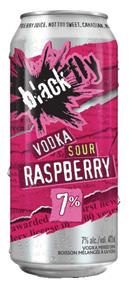





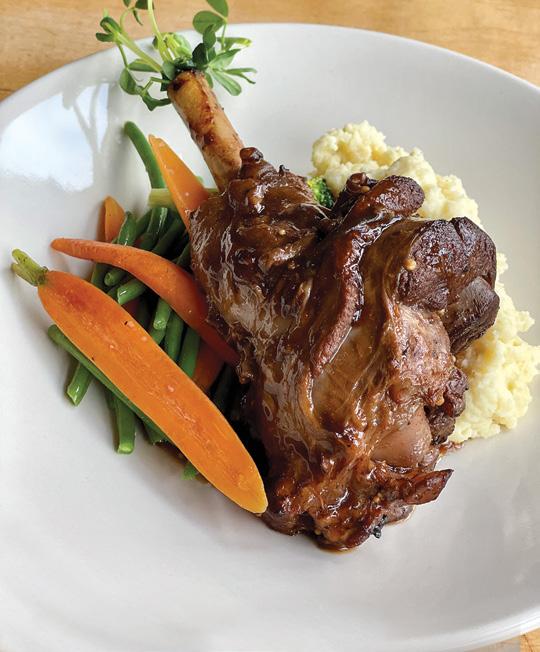
s

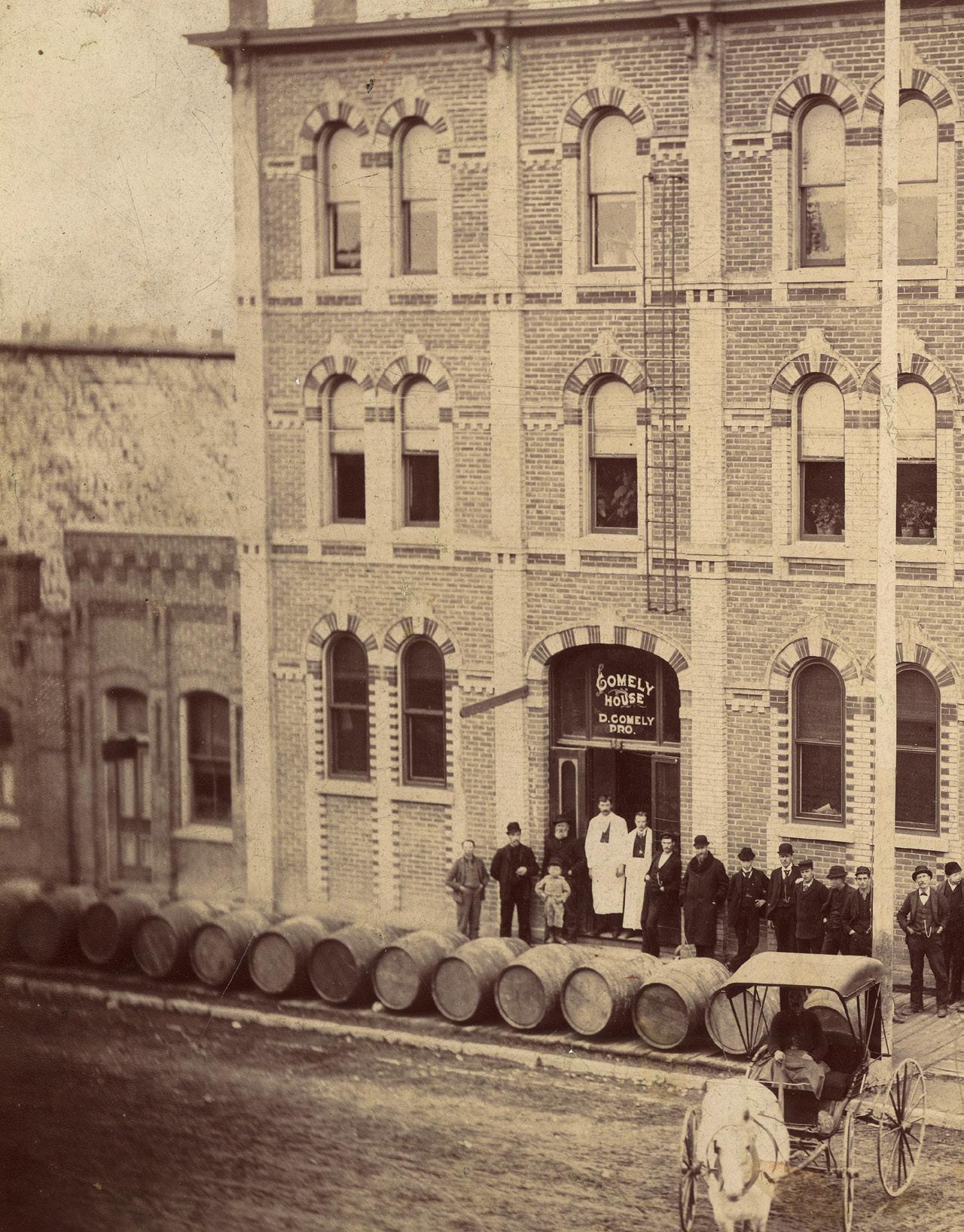
Owen Sound had the longest prohibition in Canadian history, but the liquor never stopped flowing. So what the heck happened?

istory is prone to interpretation, especially its most infamous instances. So, before we get into this story, let’s start with three facts; Owen Sound was officially dry for 66 years; it was the last remaining dry city in Canada; and owing to those things it was, for almost a century, a town divided. But—sinners? And saints? How was such polarization able to root so deeply in such a beautiful, pastoral place? To unfurl this tale with due respect, we have to go back to the start.
In the early 19th century, the dense forests and fertile land between Waterloo County and Lake Huron was known to European settlers as the “Queen’s Bush”. The area around what is now Owen Sound—the unceded territory of the Anishinabek Nation—was home to more than 1,500 free and formerly enslaved Black people, and the last place in Upper Canada to be settled. In the late 1840s Garafraxa Road between Durham and Dundas had opened (now Highway 6), Sydenham had been surveyed, and by 1857 Owen Sound was incorporated. It was the middle of the Victorian era, and it appeared to be just another frontier town positioning itself for a place on the map. Except Owen Sound was vastly different than other communities being developed in Upper Canada at the time. It had an edge that can be summed up in two words: location and timing.
Nestled in a picturesque valley of the Niagara Escarpment where the Pottawatomi and Sydenham Rivers flow into a narrow inlet of Southern Georgian Bay, Owen Sound was uniquely situated to support the rapidly growing markets and movement of European settlement. This from a historic plaque in Owen Sound’s inner harbour: In 1883,
the Canadian Pacific Railway leased the Toronto, Grey, and Bruce Railway for 999 years at an annual rate of $140,000. This amalgamation destined Owen Sound to become one of the leading cities of the Dominion, when the CPR selected the port as the eastern terminus of its steamship lines. As settlement accelerated in western Canada, Owen Sound became the busiest port on the Upper Great Lakes, earning the nickname “Chicago of the North.” Accordingly, supporting industry followed—ship building, hotels, and places to drink.
In the mid-1800s taverns were already ubiquitous across Upper Canada. In the Queen’s Bush, whiskey and beer were widely consumed by pioneers, including children who were given a daily ration because water in the area wasn’t always potable. It wasn’t unusual that drinking establishments, breweries and distilleries began to pop up in Owen Sound—it was expected. What was extraordinary, however, was the patronage.


It’s estimated that 24,000 crew would come and go from Owen Sound during a sailing season, making it the busiest port in Canada (yes, busier than Halifax or Montreal.) Simultaneously, the town became the “gateway to the west.” The CPR fleet carried 2,000 passengers each week from Owen Sound to Lakehead before they journeyed westward. Owen Sound was a bustling through point for
tens of thousands of people every year—numbers well beyond its own population and very impressive for pre-Confederation Canada, its total population less than 3.5 million.
Consistent with other port towns of the time (or even today), the vibe around town was loose. Some called Owen Sound Little Liverpool. In her book Rogue’s Wedding, author Terri Griggs describes it as “a kind of anything-goes atmosphere.” Consider the freedom that relative anonymity afforded the individuals passing through. They could carouse with whomever, brawl with whomever, and drink until




they vomited in the streets before stumbling back into a hotel bar for another round with almost nobody to hold them accountable for their actions. Now multiply that mindset by weeks stuck on a ship sailing the great lakes and add to that a lack of personal investment in a place.
“There would be two things the sailors would look for when they got to town: the oldest profession and alcohol,” says Richard Thomas, author of Saints & Sinners: The Story of Owen Sound, Canada’s Last Dry City. “In the 1870s, Owen Sound was described as a port town of between three and four thousand people, noted from Halifax to Vancouver for drunkenness and gambling. It had something like 70 bars and speakeasys for people.”
Nothing attracts a crowd like a crowd, and while itinerants far outnumbered locals, they weren’t about to miss out on a good time. The muddy streets of downtown were a carnival. So notorious were the displays of public drunkenness, brawling, and lawlessness that would spill onto the street from the four taverns at the intersection of 10th Street East and 3rd Avenue that it earned the moniker “Damnation Corners”. In winter, Thomas recounts in his book, it wasn’t unusual for sleighs to be lined up around the corners outside, farmer’s wives freezing in them as they waited for their husbands to stumble out. “The community was given the name ‘Corkscrew Town’, since it was widely believed that every adult male in the community carried a corkscrew in his pocket in case something potable turned up,” says Thomas. Not all, however, wanted in on the revelry. A block east of Damnation Corners, “Salvation Corners” was establishing itself as the architectural foil in this story, starting in 1881 with the construction of St. George’s Anglican Church and its imposing steeple. Temperance sentiment had been brewing (pardon the pun) for years before Owen Sounder Mrs. R. J. “Mary” Doyle decided to take action in 1874. She saw alcohol abuse as the cause of much suffering in the community, particularly when it came to family life, saying it created joblessness and orphans.
Per Thomas’ book, the Toronto Telegram reported: “To get to church, most of the faithful had to pass at least three of the saloons. Before the mothers and the children, the stews staggered on their rounds for the pick-me-ups that always laid them down. The regular Sunday spectacle caused a righteous revulsion.”
Doyle wasted little time and had little challenge rounding up a group to form the Women’s Prohibition Society, then circulating a petition to stop more saloon licenses being granted in Owen Sound. To address their concerns, in 1875 Council passed a bylaw to limit the number of licences granted to 13 hotels, seven shops, and three saloons. “If you’re counting, that’s 23 establishments selling alcohol to a population of 4,000,” Thomas says in his book. With that, the foundation was laid for what would become the Women’s Christian Temperance Union (WCTU)—Mary Doyle at its helm as the “mother of the WCTU in Canada”—and an almost 100-year tug-of-war.
It would take pages to detail the decades of legislation that ensued as the “wets” and the “drys” battled it out, vote after vote, so we’ve summarized the chronology in the sidebar. The critical date to take away is January 1st, 1906, the day that Owen Sound went to the polls and and prohibitionists finally got their way. On May 1st, 1906, Owen Sound officially went dry. Except that Owen Sound never actually went dry. When the weight of the WCTU came down, bootleg and moonshine sales simply went up, and people drank as much as ever. Many bootleggers were simply endeavouring to provide themselves with what they couldn’t openly buy and make a bit of cash on the side. Others, like Marjorie Paull, who has gone down in history as the busiest bootlegger in Brooke (an area across the harbour from the town of Owen Sound) took up the practice to put food on the table for her four children after her husband was left permanently disabled in a work accident. Sinner, indeed.
“All prohibition did was to drive drinking underground and make regular citizens into criminals. It was aimed at reducing crime, solving social problems, and improving community health, but people lost jobs, alcohol use increased, and crime became organized around its scale,” says Thomas. Law enforcement spent the bulk of its time handing out fines and short jail sentences, affecting little consequence. The temperance union continued to preach its messages of constraint. Owen Sound became known as the “Dry Gulch”, and the timing couldn’t have been worse.
As the eastern terminus for the CPR’s Great Lakes fleet, Owen Sound had grown at an unprecedented pace, but when the company moved its base of operations to Port McNicoll in 1912, it signalled Owen Sound’s fortunes
LEADING UP TO AND THROUGH ITS PROHIBITION YEARS.
the Garafraxa road from Durham to Owen Sound is completed 1852
Sydenham has been renamed Owen Sound; its population grows to 868 1857
Owen Sound is incorporated; its population has grown to 2,000 1861 there are nine hotels in Owen Sound 1873
in an attempt to quell public drunkenness, a new bylaw is introduced whereby taverns and saloons were to be closed by 7pm on Saturdays, 11pm on weeknights 1873 the CPR railway arrives in Owen Sound 1874
Mary Doyle forms the Women’s Prohibition Society, later the Women’s Christian Temperance Union (WCTU) 1878
following Confederation, the government passes into law the Canada Temperance Act, providing an option for municipalities across the entire country to opt into prohibition by a local plebiscite 1881
St. George’s Anglican Church is built, anchoring Salvation Corners 1883
immigrants, railway workers, and freight are passing through the Owen Sound port 1884
20,000 bushels of grain are shipped from Owen Sound 1886
the WCTU request Town Council limit liquor outlets in the town to two, restrict the shops with the sale of liquor only, and collect hotel liquor licenses at the amount stated in the bylaw, $200









changing. The vision for the St. Lawrence Seaway was being realized, and Georgian Bay ports becoming less relevant, no longer required to transport the same numbers of passengers or amount of freight.
World War I and then II came and went, and the whole of Canada grappled with its stance on prohibition, but in Owen Sound temperance sentiment held strong, even causing many of the town’s economic interests to dry up. Breweries could still make beer, but only sell to wet municipalities. Christopher and Frank Eaton, who’d run their brewery on the site of the former Riddell & Secord Brewery on Second Avenue West since 1887, were producing 6,240 barrels per year, and shipping it throughout Ontario.
When the town went dry, they shifted their focus to malt, but ultimately closed shop and left town. Schwan’s Brewery, established since 1885 and once producing about 50 barrels a day, went out of business by 1913. There were 13 hotels in Owen Sound in 1906, but with port activity dwindling and the flow of immigrants through the town slowing, before long only The Seldon


to settle over the town. The majority of Owen Sounders continued to vote to stay dry and pretend it was, while illegal drink continued to flow as sure as the sun would rise. After WWII, while the rest of the country moved forward into the second half of the 20th century embracing all the promise of post-war Canada, Owen Sound lay relatively idle.
Finally, in 1961, Owen Sounders voted to allow the Brewers’ Retail and government liquor store to open shop in the city. It took until 1971 to approve liquor sales in bars and restaurants, marking the end of the longest drought in Canadian history. “For me the thing that’s most interesting is what it did to the community emotionally and mentally to have such a divisive issue go on for so many years and then as soon as it was over nobody talked about it,” says Thomas. Where did all this leave the psyche of Owen Sound? If we measure the success of a town by its sense of community and its economic prosperity—jobs—it’s worth asking who the actual sinners and saints are in this story. Look closely, and it’s easy to see the
LEADING UP TO AND THROUGH ITS PROHIBITION YEARS.
Owen
the “drys” petition Town Council to submit the local option question to a vote 1906
Owen Sounders vote to go dry 1908 the “wets” convince the Town Council to hold a vote to repeal the local option bylaw 1909 the vote is shot down 1912
CPR moves its base to Port McNicoll 1914 Owen Sound votes again to stay dry 1917
federal government bans production of alcohol/importation of alcohol more than 2.5% 1924 a prohibition referendum is held in Ontario, and Ontarians vote to stay dry 1949
Hotel and the Queen’s Hotel were left. Both were run by drys, their purpose to ensure there were still accommodations in Owen Sound for travelers, but without the port and the immigration and, one can surmise, the opportunity to order a pint at the end of a long travel day without being handcuffed, travellers were fewer and further between. Highways were being built across Ontario and air travel was upand-coming. The script got flipped on westward journeys: instead of taking the train north to Owen Sound to board a ship, you’d take the train south to Toronto to board a plane. After years of mismanagement, both hotels were sold to private interests.
For decades a blanket of resignation seemed
elements that gave Owen Sound its unique potential in the 19th century are what present its greatest potential today. The Niagara Escarpment, two beautiful rivers, a unique harbour on what is arguably the most spectacular body of fresh water in the world. Add to that: a thriving arts and music community, a growing beer, wine and cider scene, and a fascinating, unique history just waiting to be told.
Meanwhile, all four churches still mark the intersection at Salvation Corners, while The Seldon is the last of Owen Sound’s grand hotels left standing. It presides over the harbour today, the last vestige of a Victorian frontier city in its heyday, waiting patiently to once again be the crown jewel of downtown. E
Owen Sound votes again to remain dry 1952
though “wets” are less than 2% from achieving a 60% majority; still Owen Sound votes to remain dry 1961
Owen Sounders vote to allow the Brewers’ Retail and government Liquor Store to set up shop; dining lounges are turned down 1968
another vote; once again dining lounges fall short of the required 60% to be able to sell liquor 1972
after 66 years the long drought ends as, and the last dry Canadian city approves liquor sales in bars and restaurants








When rumours began circulating that this season’s Lake Louise
Alpine Ski World Cup would be the last, I was determined to find out if the tales were true. I booked a flight to Calgary, grabbed my skis, donned my cowboy hat, and headed to one of my places in the Canadian Rockies.
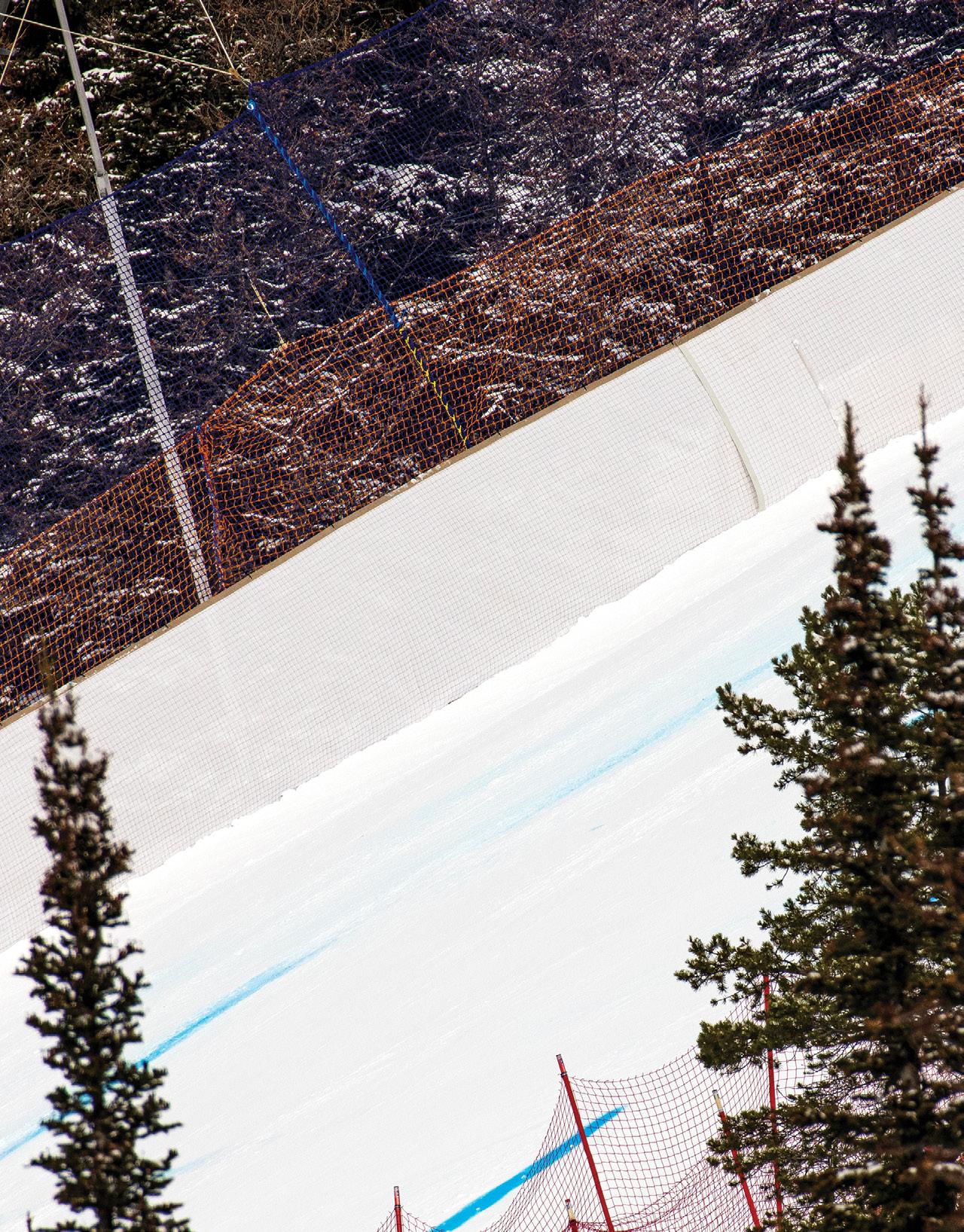
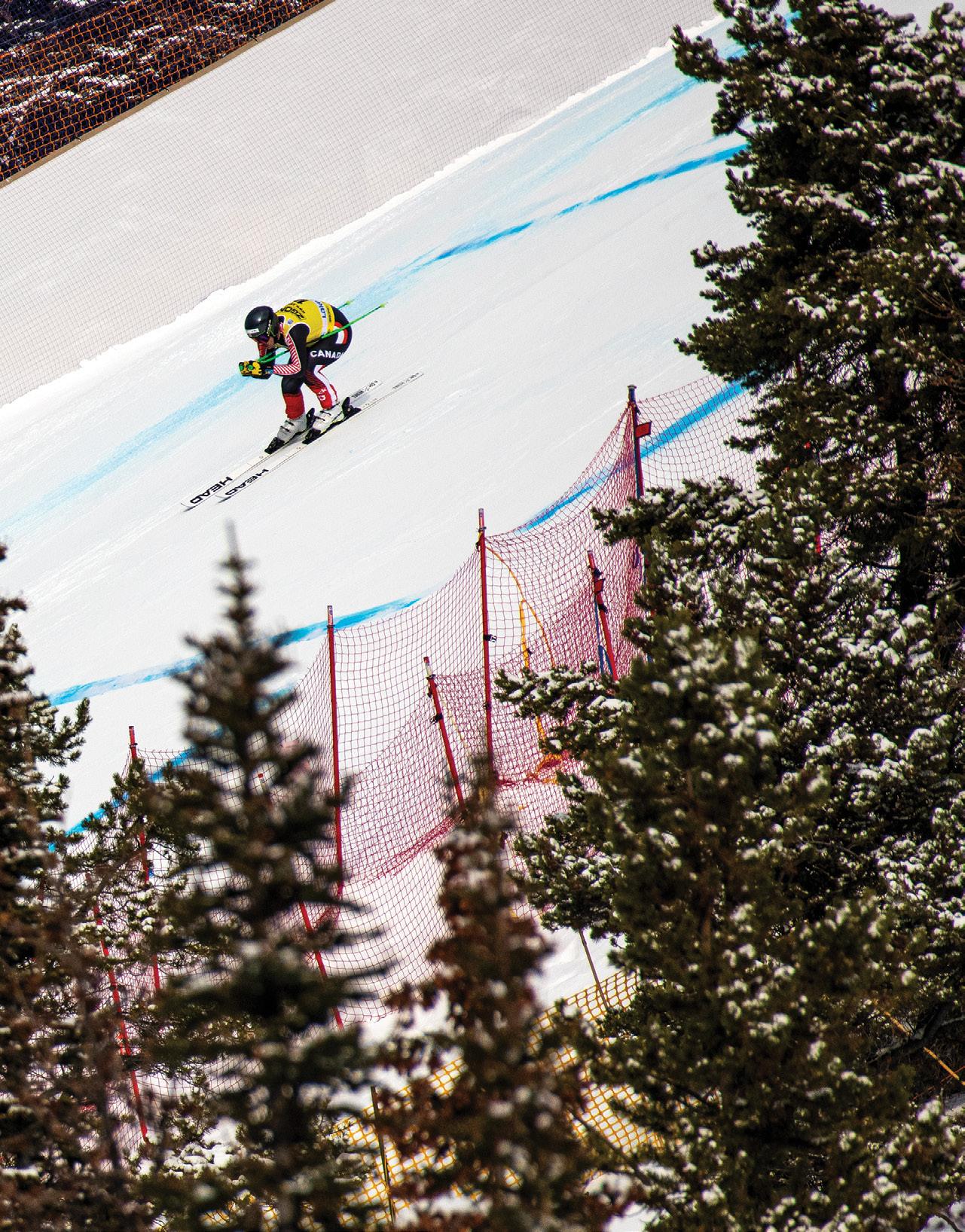
is as quaint, unhurried and unpretentious a place as you’ll find anywhere—which is probably why it’s been a favourite among World Cup athletes for over three decades. It had been nearly 20 years since I stood in the finish area and watched the fastest ski racers in the world navigate the legendary track at Lake Louise. An adrenaline-pumping, nearly month-long event with races in two categories (downhill and super-G), Lake Louise Ski Resort is (has been?) the first stop in North America for years. The only World Cup stop in Canada, it is one of the select few venues that holds both men’s and women’s races. The three-kilometre course is descended in about a minute and a half, with athletes reaching speeds up to 130 km/h. It’s hairy, scary and over the years this track has racked up dozens of nauseating highlight-reel-worthy crashes. After standing on the podium here, athletes are welcomed into an elite club. In addition to prize money, vases and flowers, each medallist gets an iconic white cowboy hat from Banff Western Outfitters—a tradition as steep as the World Cup track. While the race is broadcast globally to 174 million viewers, it’s free to watch from the finish area. And you don’t even need to buy a lift ticket.
Before I go any further, I’ll be upfront with what I discovered; the future is… cloudy. Alpine Canada Alpin (ACA) has not confirmed Lake Louise as a future World Cup host beyond 2022/23, and the Fédération internationale de ski (FIS) has yet to release the World Cup calendar for 2023/24. So, as I watched the last athlete
push out of the start gate, surrounded by the rugged beauty of Banff National Park, I reflected on the tremendous impact that this event has had on the sport of ski racing in Canada. And what it might mean if this truly is, the last rodeo.

One thing is certain—this magical place is steeped in alpine history. Canada hosted our first ever World Cup ski race on March 4th, 1980, due to the last-minute cancellation of fogshrouded Chamonix, France. The track, commissioned by the 1968 Banff/Calgary Olympic bid committee, wound down the front face of Lake Louise’s Whitehorn Mountain. It was designed by German-American Wilhelm Josef “Willy” Schaeffler, inventor of the Willy Bag and co-designer of the Dave Murray Downhill in Whistler. While the early Olympic bid was unsuccessful, the track remained—a testament to sport legacy that would prove to be an enormous benefit to Canadian athletes.
According to the late Marc Hodler (president of FIS in 1980), the Lake Louise World Cup organizing committee, and the dozens of dedicated volunteers, delivered so successfully on such short notice, the event was a key step to winning the 1988 Olympic Winter Games bid for Calgary. In total, 16 Canadian men pulled out of the start that initial year, including “Crazy Canucks” Ken Read, Steve Podborski and Dave Murray. Italy’s Herbert Plank, downhill bronze medallist at the 1976 Innsbruck Olympic Winter Games, would win the first ever Lake Louise men’s downhill.
In 1995, the event became an annual part of the women’s World Cup tour and was broadcast to an audience of over a million viewers around the world. The men’s circuit returned in 1999, at


which point Lake Louise joined the prestigious Club 5. The first downhill course outside of Europe to do so, it was officially regarded as one of the classic downhill courses in the world alongside Val Gardena, Italy, Kitzbühel, Austria, Garmisch-Partenkirchen, Germany, Val d’Isere, France and Wengen, Switzerland.
The last time I attended the event was in 2003. Austria’s
experience was as close to an actual World Cup race as you can get.
Apart from its early season reliability, Lake Louise is widely considered a favourite tour stop among athletes, due to the laid-back setting and intimate accommodations. The majority of competitors, coaches and techs stay at the luxurious Fairmont Château Lake Louise—the only World Cup venue hotel that can accommodate all international teams in one facility. If you were hoping to run into your favourite racers, you would have likely have found them in the gym, the lobby or playing shinny hockey on the outdoor rink. Italy’s Sofia Goggia (who scored a Lake Louise hat trick last season—only the third woman in history to do so) likened staying at the Château to “waking up in a fairy tale.” Lindsey Vonn has perhaps been the most vocal about her love of the Lake—at the peak of her career, she announced her desire to compete in the men’s event in 2012. This didn’t happen for various reasons, but Lindsey remained the
season—something the European resorts have not been able to deliver.
Unusually warm weather in October and November, this season prompted races in Switzerland, Italy and Austria to be canceled.

Preparation for the Alberta event began in late October with the building of the race hill, including hundreds of hours of snowmaking, grooming and miles upon miles of netting. The men raced first with two downhills and one super-G, followed by the same schedule for the women. After the last of the teams had departed (the men to Colorado, the women to Europe), the dedicated organizing committee stayed—hosting a week of Nor-Am Cup races on the race-ready track. For young Nor-Am athletes, the
“Queen of Louise”, celebrating a record 18 of her 82 World Cup victories here. In 2018 Lake Louise Resort announced the renaming of a section of the downhill, “Lake Lindsey Way”.


We bunked at the historic five-star Post Hotel and Spa which is as close to living in a Hallmark movie as you can get. Nestled in the heart of Banff National Park, with the spectacular Rockies as a backdrop, the Post Hotel is often the accommodation of choice for athlete’s friends and family. Its signature red roof and hand-hewn walls were built with logs sourced from the headwaters of the Bow River, which meanders past the hotel and cottages. The lobby is lit with antler chandeliers, rich wood walls are adorned with Canadiana artwork, and massive trophies of moose, bison and elk hang above the Riverstone fireplaces. And at the end of a long day on the slopes, the Temple Mountain Spa pools offer relaxation for those those tired legs.

“I DON’T REALLY KNOW WHAT’S GOING TO HAPPEN NEXT. IT’S A SHAME. WE NEED TO HAVE SPEED RACES IN CANADA. AS SOON AS SPEED RACES ARE GONE FROM CANADA IT’S GOING TO HURT THE WHOLE COUNTRY.”
— TRAVIS GANONG, US SKI TEAM

It’s hard to say what will happen to the small businesses, boutique hotels and restaurants in the hamlet of Lake Louise. Next autumn the women’s speed World Cup will be replaced by the recently announced 2023 women’s Alpine Ski World Cup giant slalom races at Mont-Tremblant, Quebec. I say “replaced” but I’m not sure that is entirely accurate—the Quebec races will take place on what would be the same weekend as the women’s races in Lake Louise… so, I imagine that counts as a strike against Alberta retaining the event in the future.
As the lone Canadian stop on the circuit, this is where the majority of Canadian downhillers cut their World Cup teeth. Jack Crawford, who grew up ski racing at Georgian Peaks, scored his first World Cup points here and credits the experience with familiarizing him to life on the tour. “The best part is being able to compete in front of a hometown crowd,” said Jack. “It’s been a place that’s been a huge part of my career.” Jack was the fastest among 82 starters in the first training run this season, but a mistake in the downhill race cost him. He finished 10th in the super-G and went on to win a bronze at the Birds of Prey downhill in Beaver Creek, Colorado the next week.
While Lake Louise doesn’t draw the large crowds of European events, it’s an invaluable experience for the next generation of Canadian skiers. A group of lucky U16 ski racers from the Escarpment were in the crowd to cheer-on their heroes. After spending two weeks training at Panorama Mountain Resort, the group was treated to the VIP World Cup experience thanks to camp organizer and coach Manny Osborne-Paradis. “This is the first World Cup I’ve seen in Canada,” said 15-year-old Ben White from Georgian Peaks. “It’s super cool to see all the Canadian racers at home, and knowing that they’ve gone through the same program that I’ve gone through.” With Manny’s celebrity status, the athletes had unparalleled access to the race, including the rare opportunity to
pull out of the start gate, inspect the course and rub elbows with the racers in the hospitality tent. But while the boisterous finish crowd was in top form, there was an underlying feeling of finality and nostalgia—evidently a reaction to the possibility that this may very well have been Louise’s last hurrah.
I caught up with American Travis Ganong after the super-G; “It’s pretty sad that that was my last run on the track,” said Travis, who has a vested interest in North American ski racing; he’s engaged to Canadian downhiller Marie-Michèle Gagnon. “I don’t really know what’s going to happen next. It’s a shame. We need to have speed races in Canada. As soon as speed races are gone from Canada it’s going to hurt the whole country. Luckily, we still have Beaver Creek, which will keep the culture alive in North America, but once a speed race is gone it’s really hard to get it back. It’s unfortunate, but hopefully this will wake people up, get them fired up, and we’ll get it back.”
Moments after speaking with Travis, I tracked down President and CEO of ACA, Therese Brisson. Seeking clarity, I asked the question on everyone’s mind; what’s next? “We’re committed to having a men’s speed race in the west and we’re looking at a number of venues, including Lake Louise,” said Therese. “We have a lot of work to do to have this race deliver on our objectives, which are pretty simple. First of all, the race needs to grow the sport and grow fans. Secondly, it absolutely needs to be an amazing experience for fans and the athletes. And, we need to have an event that is commercially and environmentally sustainable. Finally, it needs to leave a legacy for the sport, for the community, for the resort, including driving revenue that can be reinvested back into sport development. We don’t meet any of those objectives today, with this event. So, we aspire to innovate and transform so that we do. But we’re absolutely committed to having World Cup race in the west for men’s speed.”

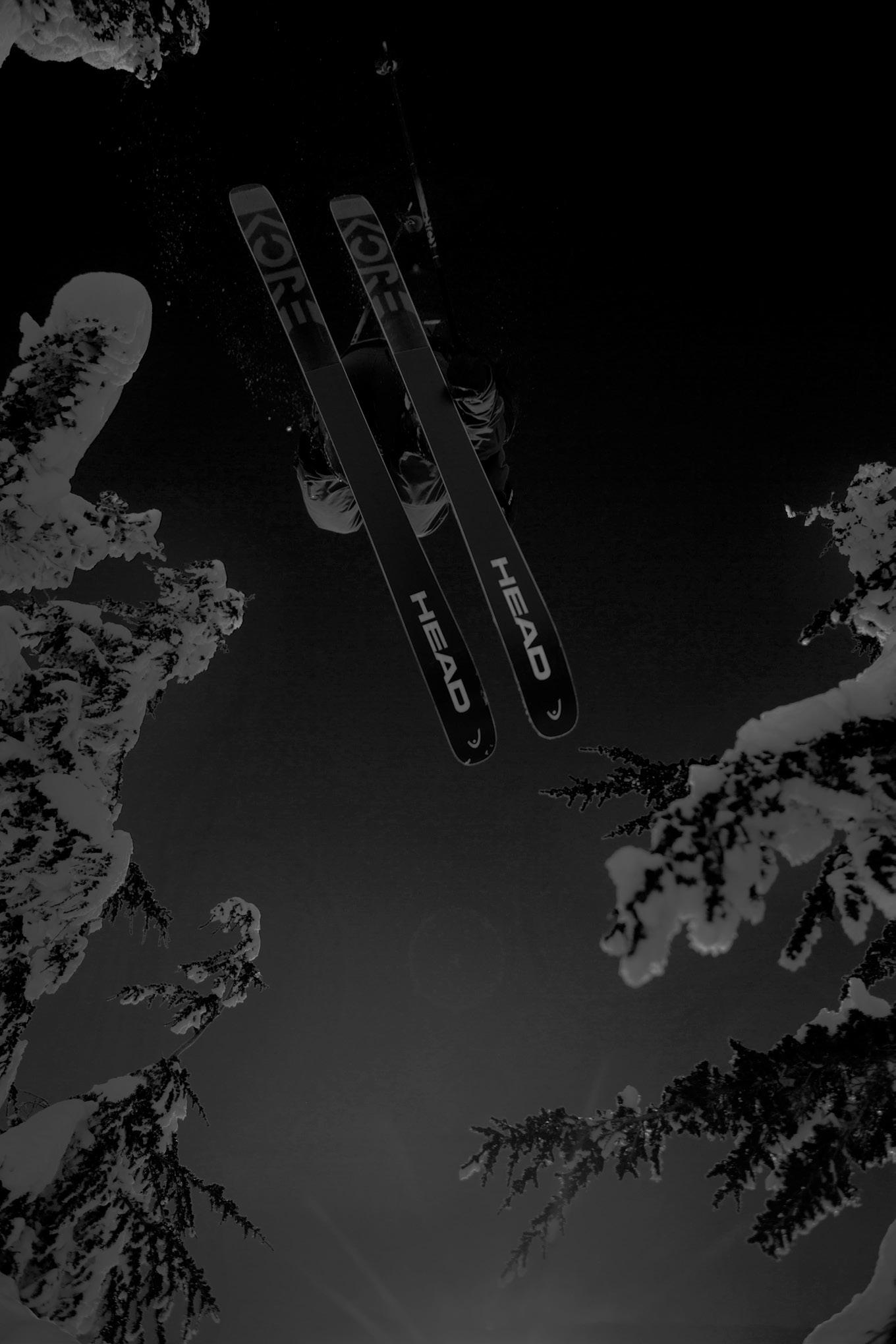


I heard from a few sources that several Canadian resorts are “keen to host World Cup events”, with Panorama and Whistler resorts churning the rumour mill. But who knows—at this point, no decision has been made—a tough blow for the army of remarkable organizers and volunteers. Led by the “Sled Dogs” and “Net Monkeys” the event is a point of pride for those who work tirelessly for weeks; from the beginning of the men’s World Cup to the last day of the Nor-Am Cup.

Whether or not this was Canada’s speed swan song, the athletes certainly put on a show. On the men’s side Norway’s Aleksander Aamodt Kilde and Switzerland’s Marco Odermatt continued their friendly rivalry for supremacy with two podiums apiece (the first downhill was cancelled due to poor visibility). Kilde won gold in the downhill and silver in the super-G, while Odermatt took bronze in the downhill and gold in the super-G. On the women’s side Sofia Goggia earned her fourth and fifth cowboy hats, winning both downhills. Cornelia Huetter of Austria took a bronze in the first downhill and a silver in the super-G, while Switzerland’s Corinne Sutter walked away with medals in every colour—bronze and silver in the downhills and gold in the super-G. This likely means she will be the last woman to win in “The Lake” for the foreseeable future.
While I hold out hope that ACA will find a home-soil alternative, there is no doubt that if this was indeed its final World Cup chapter, Lake Louise will be deeply missed. This legendary course has tested the limits of the world’s best ski racers for three decades. Cheers Lake Louise—here’s hoping that this season’s events weren’t the last chapter in your World Cup book. E

Living in the Georgian Bay area, we’re privileged to have nature’s playground right outside our doors.
Whether you’re out exploring or just enjoying the views, you can rely on Darryn, Andrew, and the team at Stroud & Scott Wealth Management to keep your wealth plan on track so you can make the most of the outdoors all year long.

Stroud & Scott Wealth Management is a proud member of the Collingwood, Thornbury, and Blue Mountain communities. We provide custom wealth solutions for families and business owners to help you build your net worth, be tax efficient, protect what matters, and build your legacy.
TD Wealth Private Investment Advice 40 Huron Street Collingwood, Ontario

Darryn Stroud, CIM
Portfolio Manager
T: 844-260-4041 darryn.stroud@td.com
Natasha McEachern
Client Service Associate
T: 705-444-1337 natasha.mceachern@td.com
Jeanine Rayner
Andrew Scott
Investment Advisor
T: 705-444-1524 andrew.scott@td.com

Client Relationship Associate
T: 705-444-5828 jeanine.rayner@td.com
Elizabeth Boni
Administrative Associate
T: 705-444-6902 elizabeth.buitenwerf@td.com
Stroud & Scott Wealth Management is a part of TD Wealth Private Investment Advice, a division of TD Waterhouse Canada Inc. which is a subsidiary of The Toronto-Dominion Bank. All trademarks are the property of their respective owners. ®️The TD logo and other trademarks are the property of The Toronto-Dominion Bank or its subsidiaries.






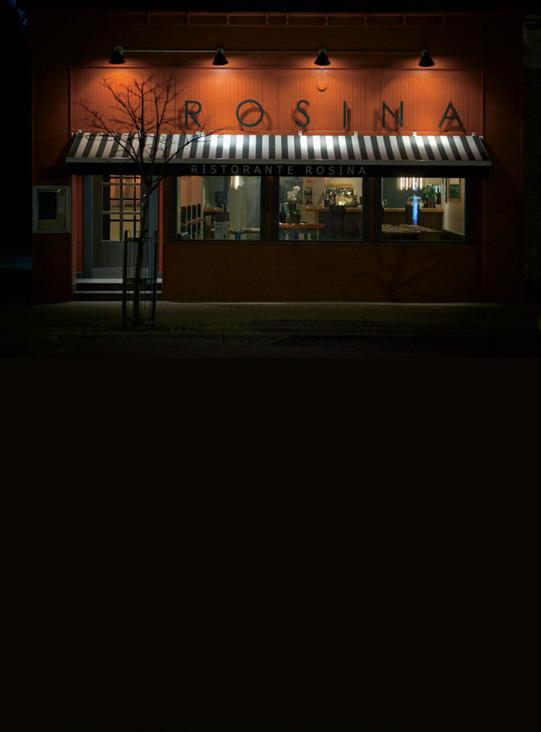








 by Cara Williams
by Cara Williams
A nod to days gone by, Blue Mountain’s newest chairlift, the Valley Express honours the deep-rooted history of the resort. In fact, many of Blue’s trails and lifts have interesting origin stories—slide on and let’s take a ride through the ages.
In my opinion, the single best name for a run at Blue Mountain is Burner. A tongue-in-cheek homage to the 3,000-foot mini-bobsled track that left many of us (literally) scarred for life, the name reflects the cement scrapes riders often earned while descending the Great Slide Ride (the gravity-fed attraction






closed in 1999, replaced by the much less dangerous successor, Ridge Runner Mountain Coaster).
Chairlift and ski trail names can inspire, trigger anxiety, or make you chuckle. Some are punny (funny puns), while others play off a theme. It’s a difficult task, filling in the blanks on a resort trail map. Names like “Smart Alec” or “Big Baby” read like taunts, while others like “Hell’s Half Acre” are suspiciously nefarious. When you scratch beneath the surface, however, the names of Blue’s lifts and trails reflect the deep-rooted history and culture of the resort, relaying stories and remembering those who laid the groundwork for the sport of skiing in Ontario.
It seems like just yesterday that Blue Mountain announced they were replacing the 25-year-old Inn Triple chairlift with a new detachable six-person high-speed lift. The old chairs found new owners all over the province and I still feel a hint of nostalgia when I spot a chair repurposed as a bench or a swing at homes around the Escarpment. The Century Express opened in the winter of 1999/2000 and as the name suggests, it honored the turn of the new century at Blue.
This past summer the hard-working operations team at Blue were busy refreshing the (now quarter of a century old) Century Express and this winter, are proud to unveil their newest highspeed six-pack lift, the Valley Express. Like many of Blue’s lifts and trails, the new name has historical significance; in the late 1920’s, a few keen trailblazers hiked through the valley to the summit of the Escarpment to explore potential ski terrain. After reaching what is now the top of Happy Valley, the group marveled at the snow-covered slope and began dreaming of a lift that would bring them back to the top quickly.
The Blue Mountain Ski Club was formed by local ski enthusiasts in 1935. With the help of the already established Toronto Ski Club (formed in 1924), by 1941 the clubs had installed two rope tows and a sleigh tow called The Red Devil. This somewhat dangerous, definitely unreliable nine-passenger sleigh was pulled by a rope-tow and was named to suit.
As the resort began to grow, the rustic beginnings of Blue Mountain Resort met with advancements in technology. The infamous machine with an unimaginative name—the North
Poma—was installed in 1955. The first chairlift in Ontario, the South Chair ushered in a new era for the resort in 1959. While it bears an equally unoriginal name, it was built to last—two of the lift towers have been preserved and still stand exactly as they were when installed. The bullwheel has been repurposed as a conversation piece and hang station for the ‘stein club’.
Staying at the south end, O-Hill and L-Hill derived their names from the large letters once painted on the limestone crest of the Escarpment. In a very different meaning than the acronym used today, “LOL” announced the Loyal Orange Lodge, the men’s society of Protestant Irish origin that came with Irish immigrants to Canada in the 1830s. Several runs were named to commemorate momentous global events, such as Kandahar—one of the original three runs cut at the north end of Blue, Kandahar was named for Frederick Sleigh Roberts, 1st Earl of Kandahar, who is credited with the relief of the city in the second Afghan War in 1880. Fast forwarding nearly a hundred years, Neil Armstrong announced, “Houston, Tranquility Base here. The Eagle has landed,” during his monumental moonwalk in 1969. Back on earth, Blue Mountain’s newest run was named Tranquility.
Many of Blue’s trail names were chosen to honour individuals whose legacy is still felt. The trail Dr. Doug was named for Dr. Douglas Firth, an osteopath from Toronto who took it upon himself to organize rescue services for injured skiers in the late 1930s. He would go on to form the Canadian Ski Patrol, serving as the president for ten years. Mary Jane’s Lane is named after the first full-time ski-patroller to be employed by Blue Mountain, Mary Jane Thomas. Rinus van der Vecht was a lift operator who tragically perished in a farmhouse fire in 1973 at the age of 23. Rinus Run, located between L-Hill and Memory Lane is dedicated to his memory.
So, when you’re out riding the all new Valley Express this winter, why not nod your helmet to Blue’s founding fathers and mothers. I imagine they would be gob smacked to learn that this small farming community has been transformed into Ontario’s largest ski destination. Heading into their 82nd winter season, it’s a fitting time to reflect on the past and the present of Blue Mountain Resort.
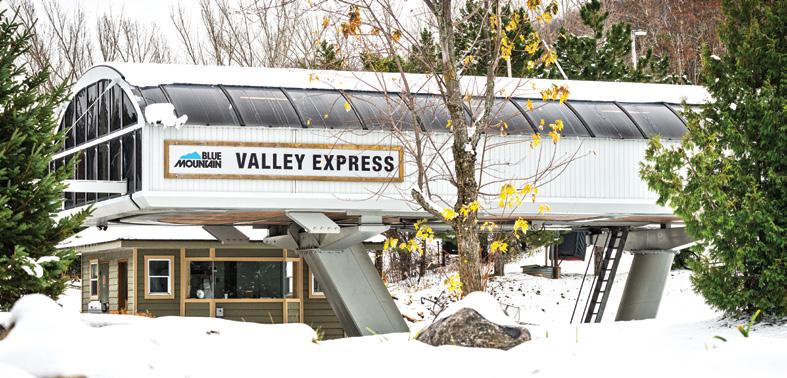






Growing up in junior ski racing at Craigleith Ski Club, Kris Mahler fortuitously met and was coached by local legend Bebe Zoricic. With a strong belief in skiing all types of terrain, Kris would grow as a person and skier under the guidance of Bebe—together they would train gates in the morning and hit the club’s ski cross track in the afternoon. During his final year in high school Kris’s family moved to Alberta, where he was invited to train with the Alberta Ski Cross team. He made the decision to pursue ski cross full-time, joining Canada Ski Cross in 2015. He placed third in Junior World Championships in France that same year.
Kris achieved his first World Cup podium with a silver at a 2019 race in Montafon, Austria. He followed with a win in Val Thorens, France, and last season he won gold at home in Nakiska, Alberta. While he’s battled injuries in the seven seasons since his first World Cup start, Kris thrives on head-to-head competition and has earned a reputation as an aggressive opponent. Looking ahead to the 2023 season, Canada will host the FIS Ski Cross World Cup Finals. The last international competition calendared for the 22/23 season, the coveted overall World Cup Champions will be crowned here, on the Escarpment, at Craigleith Ski Club, March 16-18. We caught up with Kris just before the World Cup season began.

ESCARPMENT MAGAZINE: You began skiing at the age of two. While the sport of ski cross didn’t gain traction until you were in your early teens, did you ever consider going down the more traditional route of alpine ski racing? What was it about the emerging sport of ski cross that attracted you?
KRIS MAHLER : We started skiing as a family just as a weekend sport that the whole family was able to enjoy. There was never an expectation that I would take any route within the sport. I’ve always said my dream of racing has grown as my technical skills have (over time). I did start in alpine and was very much on this route for most of my earlier years in the sport. I missed making the provincial team in my third year as a FIS athlete and that’s really when the “dream” shifted. I’ve always had an affection for jumps and terrain. I love looking at the mountain and creating an almost poetic way to ski down. I think this translates well to ski cross as there is never just one fastest line down the course.
EM: You’ve credited legendary Craigleith ski coach Bebe Zoricic with identifying you as a potential ski cross athlete—what did he recognize in you?
KRIS MAHLER : That might be a better question for him! I’d like to think he saw a hard-working, dedicated young athlete with a desire to improve and who loves the sport.
EM: Ski cross made its Olympic debut at the 2010 Olympic Winter Games in Vancouver. Since then, Canada has won seven Olympic medals in only four Games, 137 World Cup medals and six World Championship medals. We’re a powerhouse ski cross nation, yet here in Ontario, ski cross programs are relatively hard to come by and opportunities to race are few. What can Escarpment clubs do to foster athletes who have an interest in ski cross?
KRIS MAHLER : It’s no secret that the development of ski cross is lacking compared to our European counterparts. While there really is no-one-size-fits-all answer to this problem, I think the best thing athletes can do is stick with an alpine program that promotes exposure to ski cross. I came to ski cross relatively late in my career but I believe this was only possible because of the foundation of skills I was taught in alpine. Still to this day, you will find me training super-G and giant slalom events to hone in on those crucial foundational skills. I also think ski cross would make


We crafted the S/Pro Alpha 130 in collaboration with the world’s best boot fitters. Together we developed the innovative 3D instep Shell Construction, delivering unmatched foot hold for precision, control and performance in a 98mm last. Then we upped the ante on customization by pairing Custom Shell HD with Custom Tongue for next generation comfort and fit. It’s time to step into the difference.


our alpine programs more competitive. It’s completely surprising to me when we cross-train with decorated alpine athletes who can’t manage their bodies in space over simple jumps or consecutive features. I extend my contact to any coach or athlete who is interested in learning more about this sport, please reach out!
EM: Ski cross training fosters important aspects of skiing development—it exposes athletes to a variety of natural and manmade terrain, improves air awareness and ability to judge speed and trajectory. Should ski cross training be included in our junior ski racing programs?

KRIS MAHLER : 100% If you want success you need a variety of training modalities.
EM: As a teenager you played high level volleyball, earning a scholarship to Keyano College. How important is it for young athletes to play multiple sports?
KRIS MAHLER : This question ties perfectly into my answer above and really into my philosophy about sport development as a whole. Play and do as much as you can as young and for as long as you can. The studies are clear that if you want to become the most rounded athlete with the best chance of becoming that top percent, you need years of play and development. I really do believe my success comes from my ability to pull from learnings I’ve had in many aspects of my life. Expose yourself to challenges and
you’ll be surprised just how fast you learn and adapt.
EM: Let’s get technical for a few minutes— each ski cross course is uniquely built and incorporates jumps, rollers, bankedturns and myriad of terrain features. Since the start gate is the only consistent feature in a ski cross course, how important is it to develop a strong start?
KRIS MAHLER : To be quite honest even the gate is considered a changing aspect of the course. From handles that we are able to move up and down to the feature directly out of the gate changing every course there really are no two runs alike even on the same course. But yes, starts are very important as this allows you to dictate a run and generally it’s much easier to lead a pack than be the one chasing. Starts boil down to reaction time and explosive power. Everyone has a slightly different style but I’ve shown mine is one of the fastest in the world.
EM: Multiple line choices are necessary when head-to-head racing—how significant is strategy in ski cross and how important is it to have a “backup plan” in case things don’t go as planned?
KRIS MAHLER : Knowing the course is probably my second biggest energy draw apart from the actual physical racing. I lay awake at night visualizing the run-down to minute details that would drive the normal person insane. Sure, I have a specific line
that I know is fast but generally so does everyone else. So being adaptable on the course is crucial but more importantly, being confident you can be the first one to the next turn is most important. Confidence is the name of the game.
EM: Passing another athlete requires competitors to be confident and tactical in terms of where, when, and how to overtake another skier on course. What factors contribute to knowing where and when passes can and should be made?
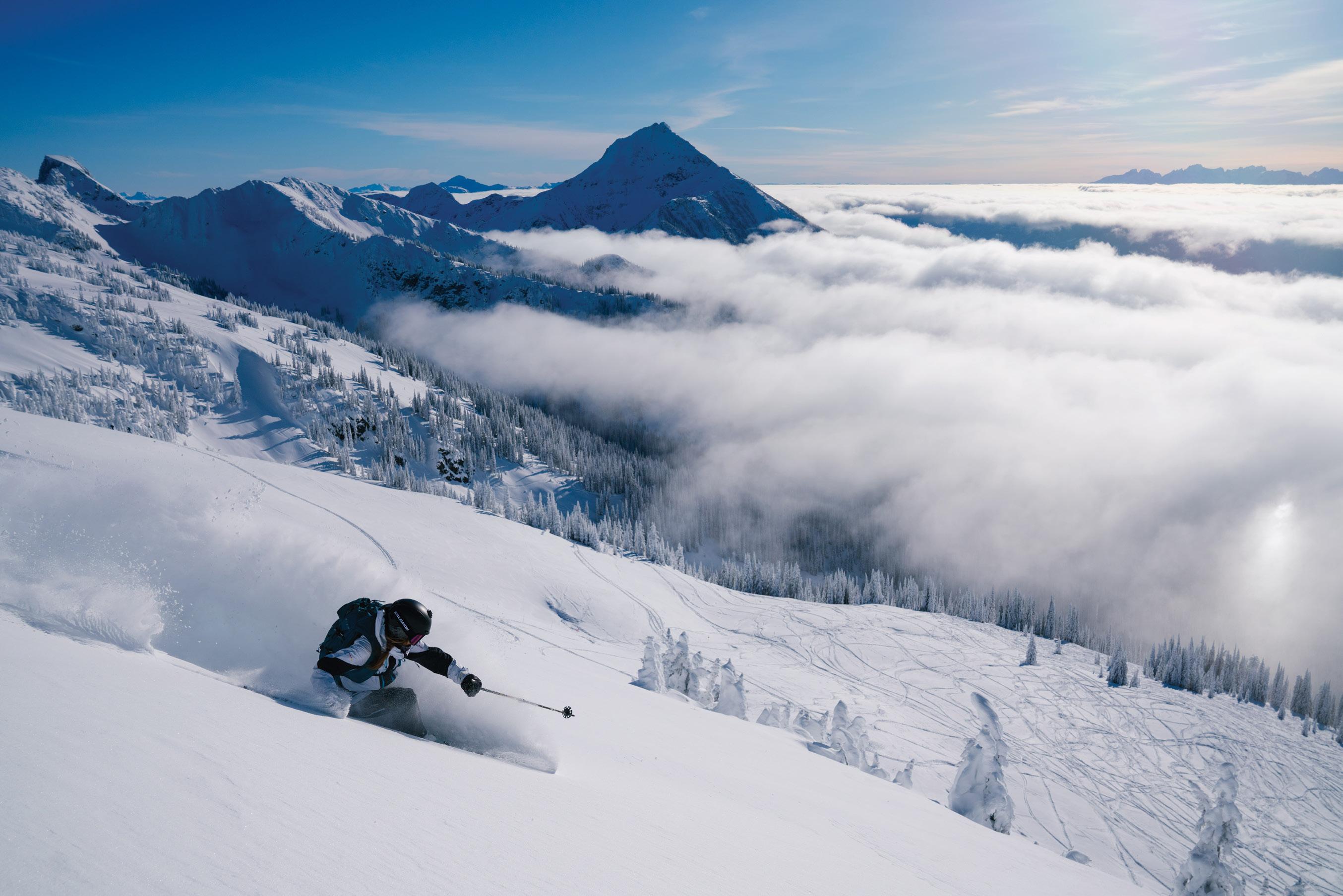
KRIS MAHLER : Well, I prefer to lead top to bottom but this doesn’t always happen, so you need to be ready to capitalize. Often times contact between two other athletes will create opportunities for the other two. Sometimes draft is all you need to slingshot past. Each course and each run has a different number of factors and this is where you see the experienced racers excel over rookies.
EM: You won your first World Cup Ski Cross in Val Thorens, France in December, 2019, and your second win came over two years later at Nakiska, AB in January 2022. Can you speak to your confidence ebbs and flows in the months in between wins?
KRIS MAHLER : Sports at this level are generally impacted more by the mental than the physical. Everyone is strong, everyone can jump, run, etc. The athletes who are able to show up mentally on race day and perform are the ones who


win medals. Much was changing between those two wins from equipment to team dynamics which all had an effect on my performance. It has all been an amazing journey of learning. While I do indeed have two wins under my belt the “Kris” that took that step onto the top of the podium was a very different athlete and person each time.
EM: Just days after your World Cup win at Nakiska, the Canadian men’s Olympic Ski Cross team was announced ahead of the Games in Beijing. As the only Canadian male ski cross athlete with a World Cup win at that point in the competitive season, many of us were stunned to see you listed

as an alternate while five other men were named to the team. Was it difficult to accept that decision?
KRIS MAHLER : Definitely, a difficult decision to accept and maybe there is part of me that still doesn’t accept it. It was a goal I was working towards for a long time. Team Canada is tasked with selecting its best team, and how that is done can get complicated. At the end of the day I know where I stand as an individual and I’ll have my chance to make my statement in four years.
EM: Craigleith Ski Club is scheduled to host
the FIS Ski Cross World Cup Finals, March 16-18. The final race of the 22/23 season, the overall World Cup Champions will be crowned, Crystal Globes will be awarded and Nations Cup titles will be presented— how excited are you to showcase the sport you love to ski racing fans on the Escarpment and around the country?
KRIS MAHLER : It’s a show you’re not going to want to miss. The best in the world are coming to my home club and were ready to throw down. It’s going to be a tight race but there’s no doubt Canada will be fighting for that top spot right down to the line.
Back after a six-year hiatus, Canada will host the FIS SKI CROSS WORLD CUP FINALS MARCH 16-18, 2023, at CRAIGLEITH SKI CLUB. This action-packed weekend is free for spectators and will showcase the world’s best ski cross athletes. The last international competition calendared for the 22/23 season, the coveted overall World Cup Champions and Nations Cup winners will be crowned. Come out and cheer on local racers Kris Mahler, Kevin Drury and the rest of the Canadian Ski Cross team. E
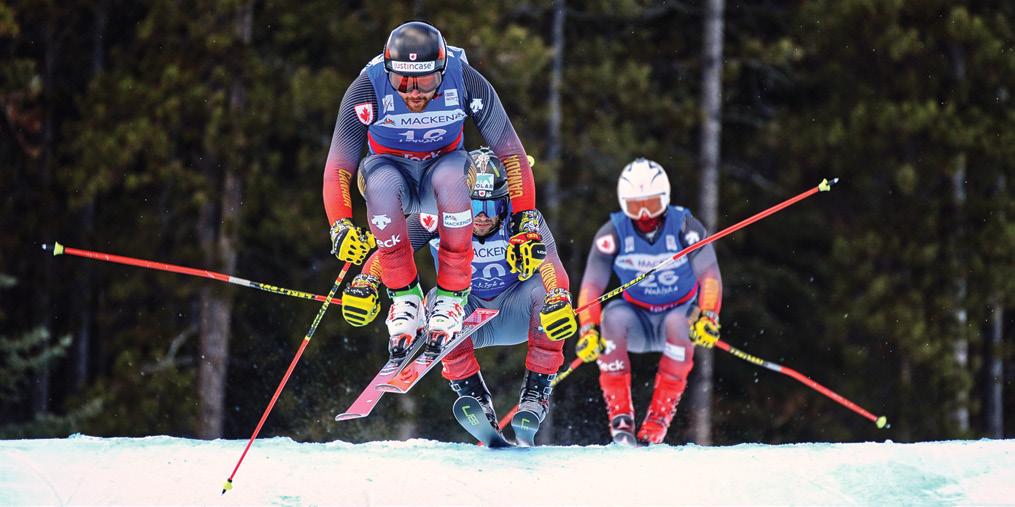




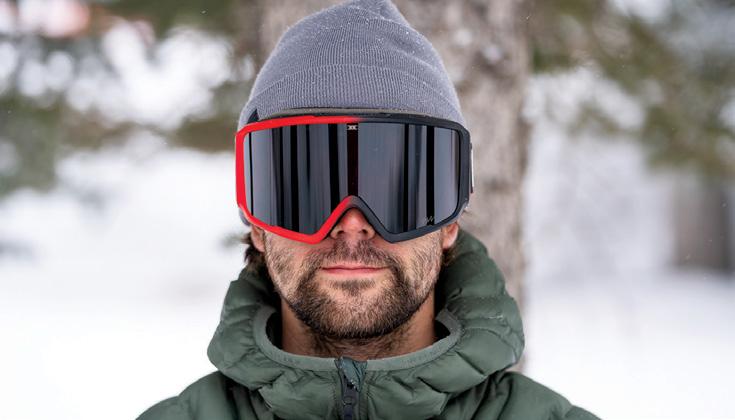




While quintessentially Canadian, the butter tart is believed to have originated across the pond, which has sparked a lively debate among Scots and French. So—who do we thank for inventing this ooey gooey treat?
by Marcia Masino photography by Clay DolanWhile quintessentially Canadian, the butter tart is believed to have originated across the pond, which has sparked a lively debate among Scots and French. So—who do we thank for inventing this ooey gooey treat? debate

You know you’re in Canada when you walk into coffee shop and see golden butter tarts displayed proudly next to the doughnuts. The Canadian butter tart is a kissing cousin to the sugar, shoo-fly or pecan pie, with a unique semi-firm, somewhat runny consistency, and topped with crunchy pecans or walnuts. Believe it or not these small indulgences actually helped build our nation as they provided the fuel ingredients of a butter or lard pastry shell with a butter, cream and sugar filling—high sugar and fat content foods were much needed by early settlers. For many English and French immigrants, whose work was outdoors and very demanding, a warm hand-held sugar hit must’ve been very welcome. The question is, when did the tart migrate? And who exactly owns the bragging rights—France or Scotland?
The sugar pie, a single-crust pie with a filling made from flour, butter, salt, vanilla, and cream, is a likely precursor to the butter tart, according to some food historians who argue the romantic French side of the question. As the story goes, the origin of the butter tart is believed to be the result of the filles du roi (known as the King’s Daughters), in which approximately 800 unwed young women were sent to Québec from France between 1663 and 1673 to help colonize (the women needed a new life and the men who were settling Canada needed brides). A clever nun named Marguerite Bourgeoys made a bargain with the French king and the filles came to the new land—the choice to marry belonged to them, not the men, while some chose to stay at the Maison Saint-
Gabriel in Montreal and work the farm and garden as well as keep house for the nuns.

I visited the filles du roi reception house at the Maison Saint-Gabriel. When I asked what these women ate, “Bread and lard” was the answer. Hard work and a plate full of fats made for a viable community of self-supporting French women in “New France” (aka Canada) who undoubtedly would have made an occasional sweet treat with ingredients familiar to them— maple sugar, cream, butter and possibly some dried fruit. Was this the modern butter tart’s foundation?
“Nonsense!” says the practical food historian Scottish side of the debate. The first printed butter tart recipe is reportedly from 1910 and clearly cites a Scotswoman’s name as the creator. Scots claim that butter tarts were originally known as “border tarts”, named so because many immigrants around the turn of the century were from Scotland—specifically the border areas, a southeast region that stretches from the English border to just south of Edinburgh. This style of tart, which has a texture reminiscent of pecan pie but is spiced with cinnamon and lemon peel and studded with raisins, is a known specialty of the borders.
Scottish immigrants living in rural Canada were likely the ones to adapt their own border aka butter tart recipes.
To support this theory the rural Ontario regions are filled with celebrations of the gooey homage to sugar and fat. In Ontario alone, you can tour butter tart events in over fifty communities that honor the beloved dessert with festivals and baking competitions.
Today as many chefs reimagine the recipe, butter tart purists stick to the traditional technique. And I have it on the down low that a certain nation known as “the world’s factory” has plans to make the butter tart the next global phenom, but who knows?
The butter tart has a bright future and will always be a source of national pastry pride for Canadians. E







“
CAREY – FILLER
“
CAREY – FILLER
CAREY – FILLER
Juicy lips, contoured cheeks, snatched jawline—must we say more?
“Juicy lips, contoured cheeks, snatched jawline—must we say more?
Juicy lips, contoured cheeks, snatched jawline—must we say more?
Restore volume and hydration to your favourite features using a Hyaluronic Acid based Filler.”
Restore volume and hydration to your favourite features using a Hyaluronic Acid based Filler.”
Restore volume and hydration to your favourite features using a Hyaluronic Acid based Filler.”
DR
“
“
“
DR MITCHELL – BROTOX
DR MITCHELL – BROTOX
Yes, you read that correctly—Brotox. The ladies aren't the only ones who get to age gracefully around here!”
Yes, you read that correctly—Brotox. The ladies aren't the only ones who get to age gracefully around here!”
Yes, you read that correctly—Brotox. The ladies aren't the only ones who get to age gracefully around here!”
CHRISTINE – IPL
CHRISTINE – IPL
CHRISTINE – IPL
“
It's IPL season! This treatment will help repair any pigmentation or sun damage we inevitably pick up over those warm summer months and reveal that beautiful glowing complexion!”
“It's IPL season! This treatment will help repair any pigmentation or sun damage we inevitably pick up over those warm summer months and reveal that beautiful glowing complexion!”
“It's IPL season! This treatment will help repair any pigmentation or sun damage we inevitably pick up over those warm summer months and reveal that beautiful glowing complexion!”
HILLARY
“
HILLARY – LASER HAIR REMOVAL

Put down the razor—your future self will thank you! Never worry about stubborn ingrown hairs, or razor burn again. Enjoy the convenience and confidence after a series of treatments.”
“Put down the razor—your future self will thank you! Never worry about stubborn ingrown hairs, or razor burn again. Enjoy the convenience and confidence after a series of treatments.”
“Put down the razor—your future self will thank you! Never worry about stubborn ingrown hairs, or razor burn again. Enjoy the convenience and confidence after a series of treatments.”
KASSIDY – CHEMICAL PEEL
“
KASSIDY – CHEMICAL PEEL
KASSIDY – CHEMICAL PEEL
This is my favourite treatment to keep my skin refreshed and hydrated during these cooler months. Especially when paired with a HydroJelly mask!”
“This is my favourite treatment to keep my skin refreshed and hydrated during these cooler months. Especially when paired with a HydroJelly mask!”
“This is my favourite treatment to keep my skin refreshed and hydrated during these cooler months. Especially when paired with a HydroJelly mask!”
At a recent eye exam, I was told I have ‘unusually good’ vision, which likely means my eyesight is at least 20/20, and I’m in my late 40s. Consequently, my optometrist’s recommendation was to “keep doing what you’re doing; nutrition and lifestyle.”

So, here are some nutrients, foods and habits that have been shown in studies to favourably support healthy eyesight*.
WAYS:
• Reduce oxidative stress to the tissue (free radical damage)
• Help prevent macular degeneration
• Reduce risk of cataracts
• Strengthen the tissues in the eyes
• Prevent and treat chronic diseases that can damage eye function, such as diabetes
FOODS AND THEIR KEY NUTRIENTS FOR VISION HEALTH: Green leafy vegetables, eggs (yolk): lutein, zeaxanthin, folate Citrus, vegetables: vitamin C
Eggs, cold water fish, raw nuts, olive
and flax oils: healthy fatty acids
Green leafy vegetables, beef, legumes, pumpkin seeds: zinc
Sweet potatoes, raw nuts: vitamin E Butternut squash, carrots, sweet potato, spinach, red and orange peppers: beta carotene (the more intense the colour, the more beta-carotene is present)
Purple cabbage and carrots, beets, wild blueberries: anthocyanin
Not only are these foods good for eye health, but also for many underlying causes of vision changes, such as diabetes, hypertension and obesity.
1. Shade eyes from direct sunlight with a brimmed hat.
2. Protect eyes from reflected light with sunglasses, such as from water, snow, and other vehicles while driving.
3. Give your eyes a rest; if you work at a computer, look away from the monitor every 20 minutes and focus on something at a different distance.
4. Receive regular eye exams and seek immediate immediate consultation for
Dr. Shelby Worts, BSc, ND
any vision changes.
SO, HERE ARE A FEW HABITS THAT ARE LIKELY CONTRIBUTING TO MY HEALTHY VISION:
• Consuming a lot of intensely coloured produce, such as dark green spinach, kale, carrots, beets. These are also grown locally.
• Boosting the orange colour of my favourite squash soup recipe by adding turmeric root, carrots, and sweet potato.
• Wearing a brimmed hat to protect my eyes from sunlight while outdoors for extended periods, such as yard work and long walks.
• Although I work all day on a computer
I am constantly switching between looking at the monitor and focusing on my patient’s face during a consultation. My eyes are repeatedly adjusting to different distances.
Staying well hydrated, of course. Please note there are many underlying causes of vision changes—be sure to discuss these with your qualified health care provider.
To maintain good eye health, focus on a diet rich in colourful vegetables and fruits. To improve or stabilize eye health, consume a colourful diet with the addition of appropriate supplements from a good quality source.
Our ability to view the world is a beautiful thing—let’s take care of this amazing sense!
*These are general suggestions and should not be interpreted as medical advice. Discuss this with your qualified healthcare practitioner. E
Optimize your eye health with nutrients, foods and lifestyle habits











On a journey of discovery with a passion to tell a visual story, Harvey Bodach has explored wilderness zones throughout the globe—observing the natural world and its wildlife. His passion, focus, and inspiration drive him to recreate and share his own experiences with truthful accuracy and detailed realism through his art.
s

Positively awestruck by the natural world, Canadian landscape and wildlife artist, Harvey Bodach is enthralled with its diversity, complexity, and beauty. His reverence for wilderness landscapes and wildlife is translated flawlessly using minute detail and careful design within his paintings. Harvey considers himself an uninvited guest when travelling through remote areas looking for subject matter; “I become aware that I am a stranger, an uninvited guest with tensions arising, but soon nature embraces me when my motives are proven pure. It is at this time that I become a witness to a spectacular drama, the wildlife and their interactions on a stage which is the landscape—all perform a wonderful play before my eyes.” His determination for recording what he sees is palpable. “The artist within me wants to preserve the experiences, the memories that I have been privileged to have had, by recording them in shorthand first with sketches and photography in the field. Moreover, the artist within wants to understand the mysteries that are life on earth, then by paintings, sculpting and drawings, express it in art.”

Always seeking the unusual, Harvey’s favourite landscapes are ones that leave a lasting impression, mysterious in their shape and design, invoking a sense of respect and awe. “I paint major compositions with this in mind, directing the eye of the viewer through every important part of the painted surface, like an orchestra leader directing each player.”
“With wildlife, there is something to be said about the portraying of the majestic. The Bald Eagle with wings stretched out and soaring through the sky, an Osprey or the Belted King Fisher diving into the water for fish and stretching wings out for flight, even the Lynx springing through the snow after a Snowshoe Hare with its thick winter coat. They really stand out in a painting like a pedestal. There is also something to be said about seeing the mysterious; like a cottontail rabbit hidden in winter grasses that can surprise the traveller. Even the comical; seen with a chipmunk traversing a branch hanging over water, then falling in and having to swim back to shore.”
Harvey truly perceives the landscape as a stage and the wildlife its characters. “In my landscape and wildlife art, both need to work in concert with each other. Facts and details need to be accurate and s


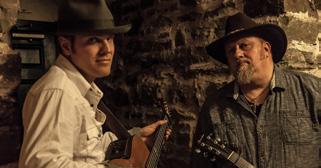




truth its foundation. The interaction of both is what I want to understand first, then paint in order to share my story. The technical challenges that come with each work of art are for me the seeds growth as an artist, because I strive to be better— nearly perfect—before signing.”

As a child, Harvey describes himself as having been, “selfmotivated, energetic, curious and creative.” Growing up in
Toronto, firstly on the fringes of High Park then out to the suburbs, he was an overly-active kid—playing baseball, football and hockey, running track and going camping, fishing and exploring parks, zoos and the world at large. “These interests and patterns were laid down early in life and became a foundation for interests and patterns that continue to this day. They helped create a deep passion for creating landscape and wildlife art and are still a major driving s






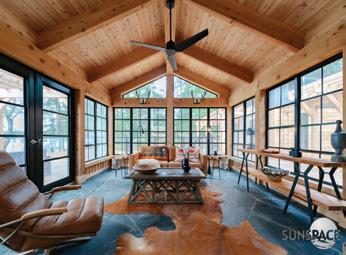

force in my life now.”
Public recognition of his budding artistic talents—drawing, painting and building architectural structures—began in elementary school. Then, in high school, the study of art history and post modernistic movements helped refine his perspective and expand his creative mind. He continued perfecting his favoured realism style but also experimented with impressionism, pointillism, cubism and others. School exhibitions brought both recognition and sales.
Earning a fine arts honours degree from York University, Harvey was introduced to classic works of the old masters and new mediums for creating structures like wet clay, laminated woods, and fiberglass which were eye opening and remain an influence to this day. Even though the art world was becoming enthralled with the modernist art movement, Harvey’s passion for realism became bolder. “By the end of my undergraduate studies, I had solidified my collection of art heroes—each chosen for reinforcing the passion I had in art, the direction I wanted to take and the style I wanted to work in—that of landscape and wildlife art recreated with a realistic style.” For 18 years Harvey worked commercially as a graphic designer, illustrator and art director (including five years of part-time freelancing in both the visual and commercial arts). Harvey then went on to earn a Bachelor of Education from Brock University as well as additional qualifications in visual arts and technical studies with the Ontario Institute for Studies in Education, University of Toronto and Mohawk College. In 1999, Harvey signed with Peel District School Board and for the next 20 years taught visual arts and multi-media technologies in high school. Retirement brought Harvey and his family to the shores of Georgian Bay in Thornbury and the launch of his now full-time career as an artist.
Always exploring, Harvey has travelled extensively throughout North America, Europe and the Middle East. Equipped with sketch pads, pencils, SLR camera, a backpack, and little else, he was equally as captivated by Israel’s soft morning light as with Northeastern Arizona’s desolate canyon lands. “Landscapes are seen by me as distinct ecological systems in which life thrives or barely survives. They also reflect a rich geological history which at first glance seem puzzling, mysterious, even making one stop to ponder life itself. I look at the landscape as a stage for presenting the wildlife and choose ones that









are unusual, distinct, but always in sync with the ecological context. When laying out the design of the composition, I become an orchestra leader who instead of directing the players, directs the eye throughout all the wonderful areas of the landscape.”
Working primarily with acrylic and oil-based paints as well as watercolours, Harvey produces extensive preliminary sketches and his photos are a key part of the process. His go-to assistant is Photoshop. “It allows me to refine the quality of photos, including colours, shadows, and details which in the end, help perfect the final work.” Because of his realism style, he prefers non-canvas boards for his surfaces and has developed his own system for preparing Masonite boards using multiple layers of gesso to build the ground surface and then sanding them to create a smooth working surface. “This offers better technical control when painting the details of landscapes and wildlife with a realism style,” explains Harvey.
“Before painting on either board or paper, each surface is given an under drawing as a guide that reflects in approximation the overall compositional design of the best sketch which has been
tested and proven to work. Changes can still be made at this stage before applying the paint. The next stage is applying either acrylics or oil-based paints to the Masonite board in layers. The first is used to just block in rough shapes, lines and colours over the entire board surface and then to build up the surfaces. There may be between eight or ten layers with this building approach. Both mediums can give you a translucent result, acrylic paint does it with the increased water saturation and oil paint does it with linseed oil. Best results come with the increased level of a layering approach.”
A multiple award winner, you will find a detailed list of Harvey’s accomplishments as well as information about his future plans and exhibitions on his website. Also a sculptor, Harvey produces wildlife moments captured in action using water-based clays, fired once to bisque and painted with acrylics. He plans to expand this area of his art.
More information about Harvey and his artistic endeavours can be found on his website: harveyboach.com

“THE ARTIST WITHIN WANTS TO UNDERSTAND THE MYSTERIES OF LIFE ON EARTH, THEN BY PAINTING, SCULPTING AND DRAWING, EXPRESS THESE IN ART.”
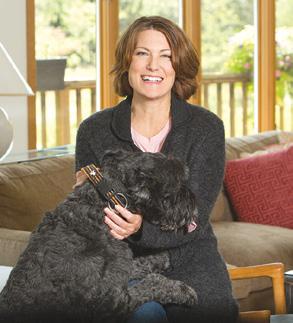

























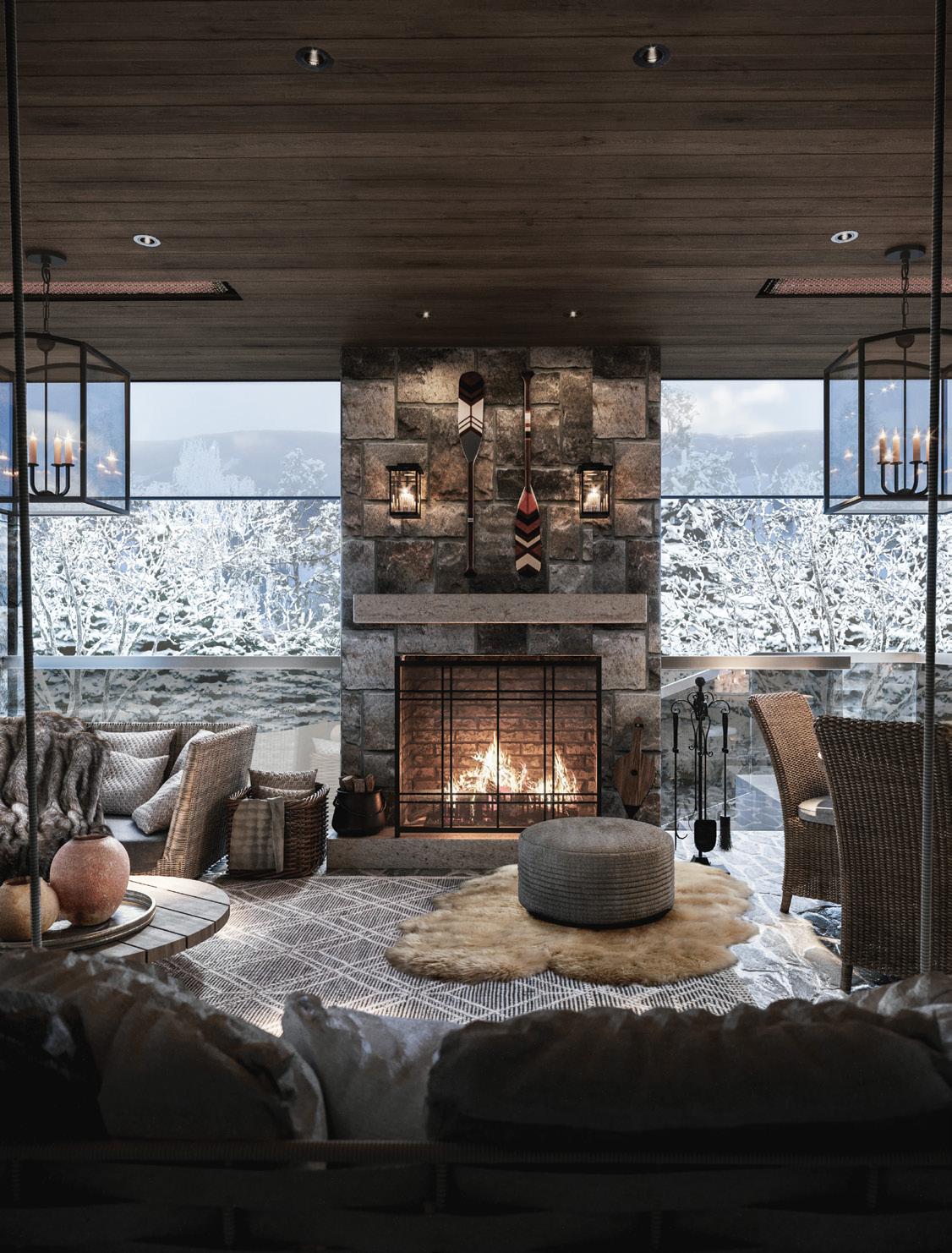






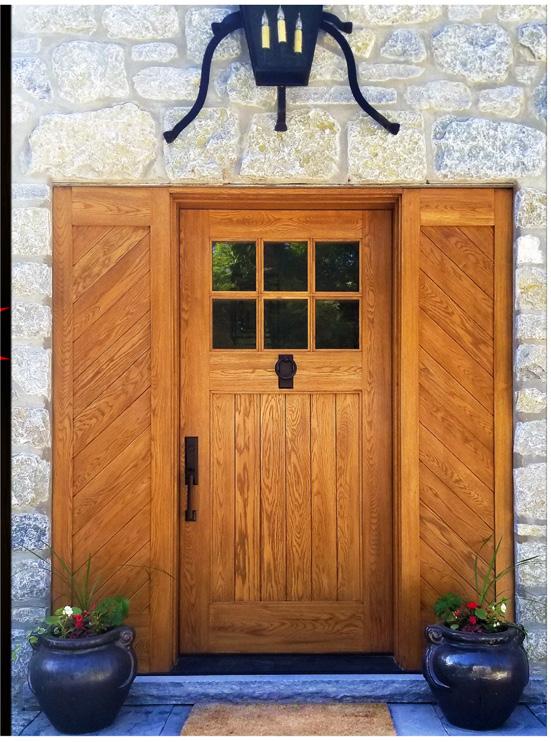

 by Jo Redman, HBA, BED, DID, NCIDQ
by Jo Redman, HBA, BED, DID, NCIDQ

A unique front door has long been a factor in curb appeal. Not only a welcoming entrance to your home, it’s also a statement about who you are—a reflection and continuation of your individual style. s



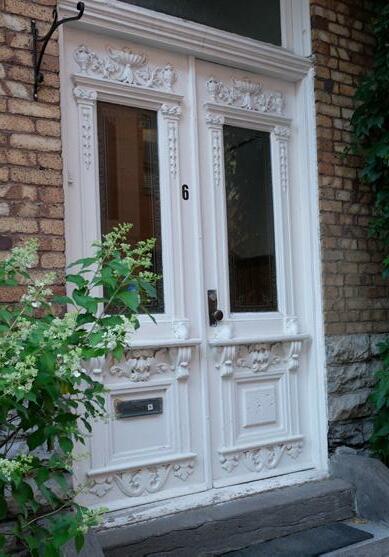

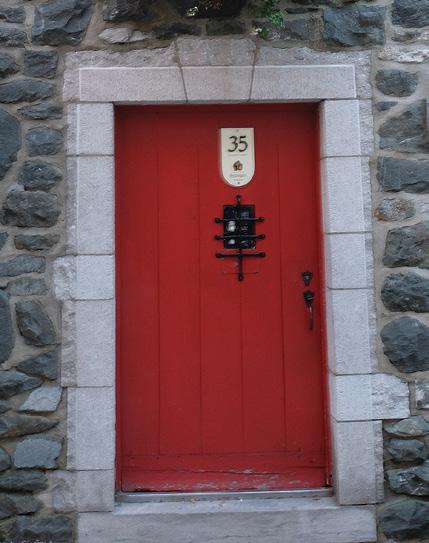
thinking back fondly on a trip to Québec City, I remember the sun peeking through the antique double doors at the historic Auberge Place D’Armes. Constructed in the early 1600s by Guillaume Couillard (one of the first French settlers to the area), amazingly the current hotel owners are direct descendants of Couillard.
I headed out onto the cobblestone streets and found myself completely immersed in the architecture of Old Québec. I was particularly drawn to the colourful array of exterior doors adorning homes throughout the neighbourhood. I’ve often wondered what lay on the other side of those thresholds—who lived there? And, did the colour and style of the door reflect the personality of the inhabitants?
The earliest recorded doors appear in paintings of Egyptian tombs. A symbolic gateway, they often depicted illustrations of the afterlife. The ancient Greeks and Romans built impenetrable doors in solid bronze, silver, and brass, which offered protection and safety to residents within.
By the 12th and 13th century, doors were more often made of wood. Reinforcing the door with iron bands and steel studs symbolized prestige, status and wealth.
Today, our homes speak volumes about our personalities and our front doors form the important first impression. Painted front doors add colour, charm and curb appeal to your home, not to mention making it easier to give directions (second house on left with the bright yellow door). When advising my clients on door design and shape, emphasis is placed on the architectural vernacular, while colour is a personal choice. Whether bright and bold or subtle and subdued, door colour is a statement in itself. Knowing the hidden meaning behind colour choices can be fun and enlightening.
BLACK DOOR: is akin to a little black dress— a never-go-out-of-style classic, often associated with sophisticated elegance. Take it a step further
and add drama by using a high gloss finish with a pop of old brass or silver hardware.
RED DOOR: evokes vibrancy and excitement and is most commonly seen in colonial style homes. A popular feng shui choice, a red front door is considered to be lucky, welcoming and auspicious. In Scotland it symbolizes that the homeowners are mortgage free.
BLUE DOOR: signifies unity and calm. Royal blue is considered more playful than soothing lighter shades, while navy is classic, conservative and neutral in nature. A blue door welcomes prosperity and growth.
YELLOW DOOR: is bright and inviting and belongs in the homes of people with an upbeat, positive disposition. It begs you to take a peek inside—colourful palettes are sure to be found!
GREEN DOOR: traditional, reflects wealth, health, and safety. A deeper shade symbolizes peace and prosperity, while vibrant lighter hues suggest that energetic, outdoorsy adventure seekers live within.
WHITE DOOR: is usually associated with
clean, simple and serene energies. Typically found in Scandinavian design and seaside escapes, in feng shui white doors signify a fresh start or new beginning.
PURPLE DOOR: symbolizes prosperity and fortune. Throughout history, purple dye was extremely rare, therefore the colour became synonymous with wealth and royalty. Today, a purple door suggests creativity, and a richness in quality of life.

STAINED WOOD DOOR: adds a sense of warmth and can provide a strong contrast to clean stark lines of modern architecture. A stained wood door can also be a great choice for a more rustic setting like your typical cabin in the woods.
When choosing a new front door, it’s keenly important to think about energy efficiency, maintenance, cost, and style. And it’s one of the easiest and least expensive things you can do to add instant curb appeal your house. After all, your front door is not only an entrance to your home, it’s also a statement about who you are.







The pandemic altered the world forever, resulting in monumental societal changes. Particularly affected were urban dwellers—many of whom sought respite beyond the city, taking refuge in the small-town charm and natural splendour of Simcoe, Grey and Bruce.

This is the story of two Toronto couples and their families who, faced with the confines of city life and a sudden desire to break away to greener pastures, chose to put down roots in our region. Linking the two is a successful local builder and his designer partner who tuned in to their needs, desires, and differing visions of a better life to help them create places they could truly call home.
s
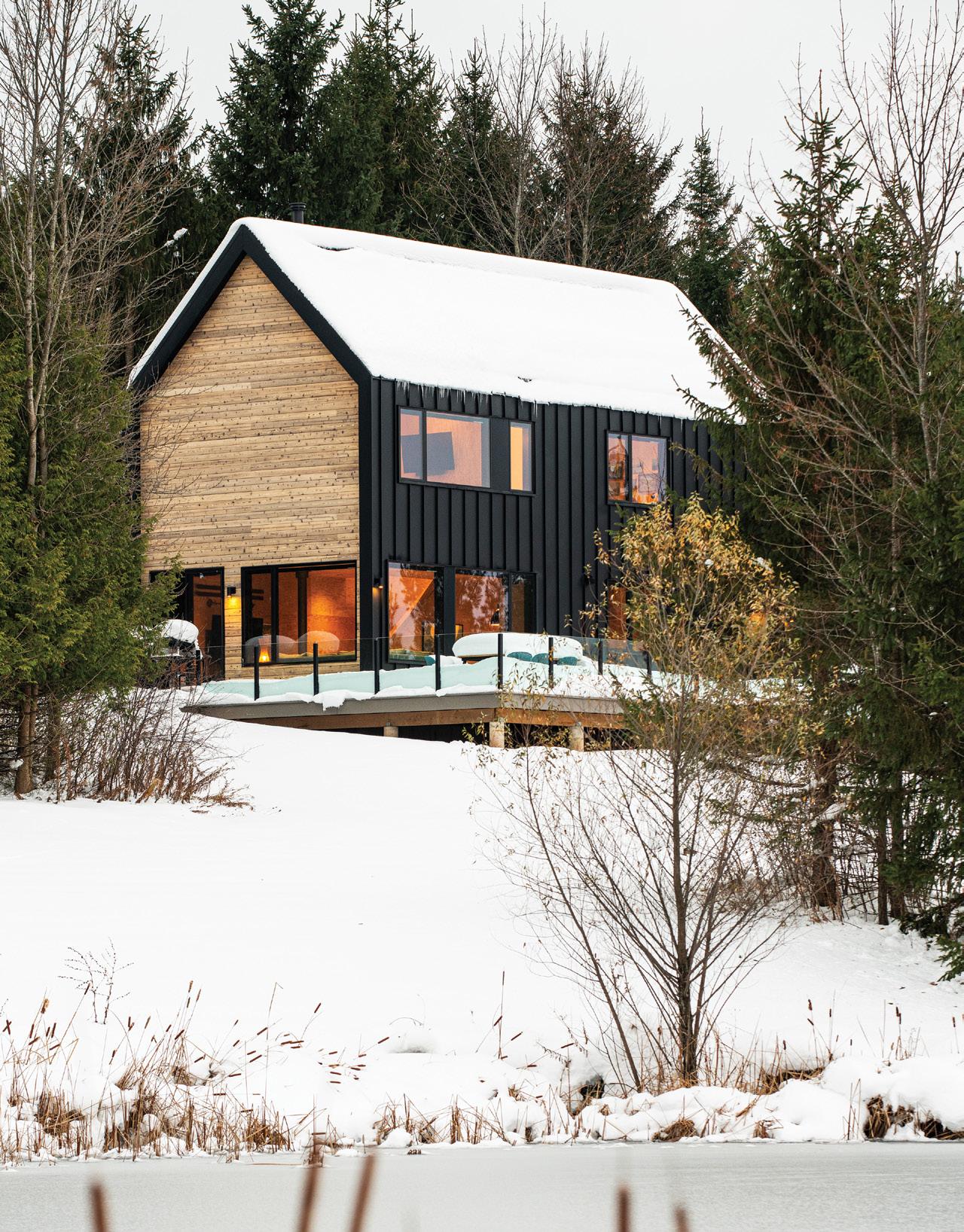

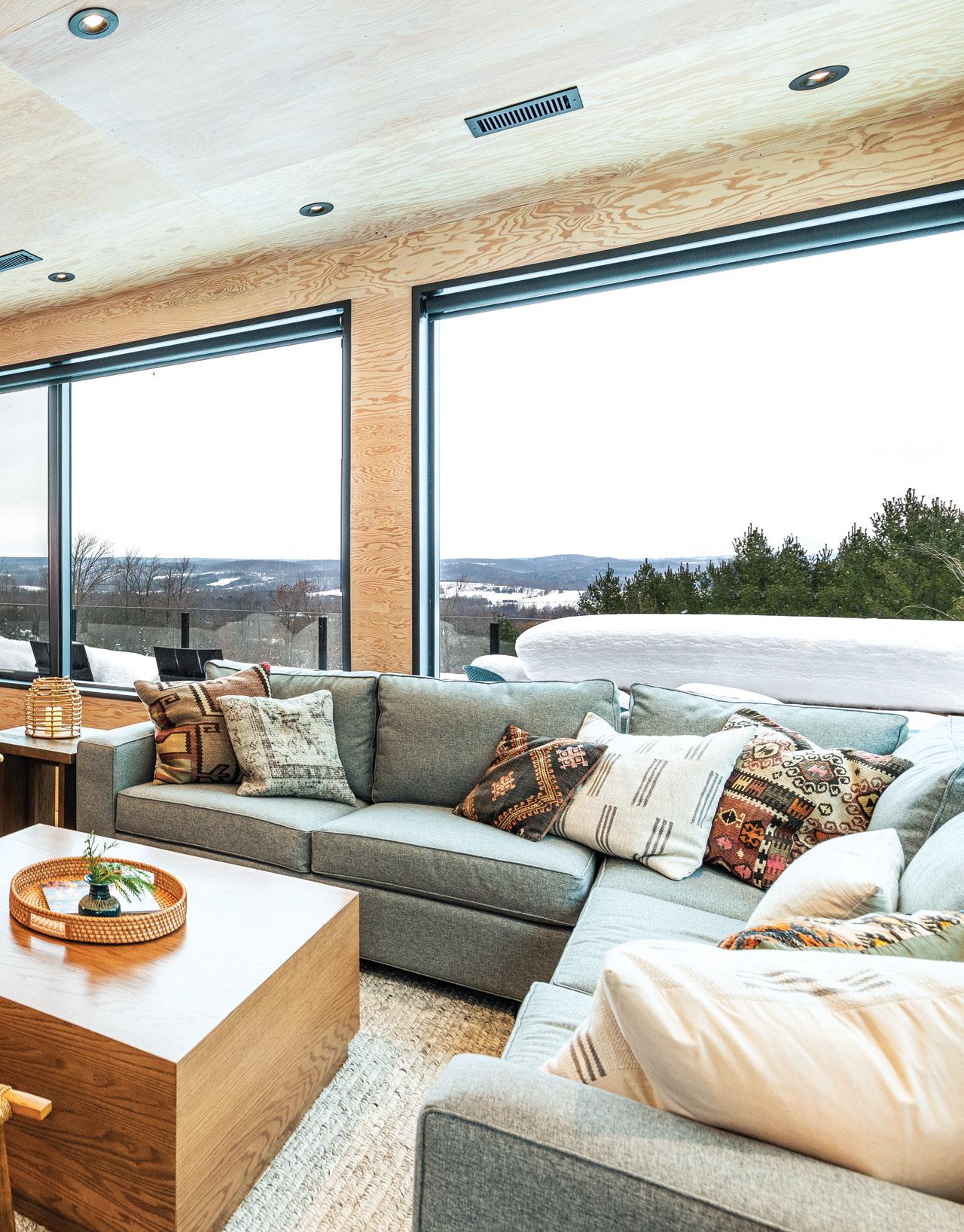
For many years, Toronto real estate professionals Lindsay and Will Jephcott and their four children loved getting away from the city to unwind. The hundred-acre country property near Uxbridge, Ontario, had been owned by Will’s family for over one hundred years. But a few years ago, the family moved from the property. This left a gap in the Jephcott family’s lives, so the couple went looking for a similar tranquil and private experience for their children.


“We decided it was time to get the hell out and find our own property in nature, with no possibility of development in sight— a place where we could turn off and enjoy family time together,” says Lindsay. “The arrival of COVID in 2020 sped things up for us. After some health issues in our family, we discovered to our shock that our Lawrence Park home had a major mould issue, so we needed to rent until the problem was resolved. We didn’t want to get stuck renting in the city during the pandemic, so we decided to move up north, and started exploring.”
The Jephcotts first started to look for acreage near Creemore, where they had been renting, but soon discovered that they were out-budgeted for the space they were looking for. “Our search kept getting pushed out farther west, until we found a beautiful, private 40-acre property west of Meaford near Walters Falls,” Lindsay recalls.






“It was perfect for our active family. Here was a place where we could hike, snowshoe, ski, and swim in a spring-fed pond right from our doorstep. And there was a large barn which offered many opportunities.”
Although there was an old log cabin on the property, Lindsay and Will decided to build a new home tailored to their desire for simplicity, comfort, and an outdoor lifestyle for their growing family. They chose local builder Blake Farrow and his wife Marina Farrow, an interior designer with Farrow Arcaro Design in Collingwood, to help them build and realize their vision.

“What we were looking for was a home that was compact, efficient, self-sufficient, and not too big—just three bedrooms and one bathroom to encourage the family to spend time outdoors, while encouraging sharing among our kids,” says Lindsay. Following their unpleasant experience with mould in their Toronto home, the Jephcotts decided to avoid potential water issues by omitting a basement altogether.
“We wanted the house to look understated, cool and different, so we agreed with Blake Farrow on a simple and space-efficient ‘Scandinavian cabin’ design with minimalist décor,” Lindsay adds. s
“We wanted the house to look understated, cool and different, so we agreed with Blake Farrow on a simple and spaceefficient ‘Scandinavian cabin’ design with minimalist décor.”


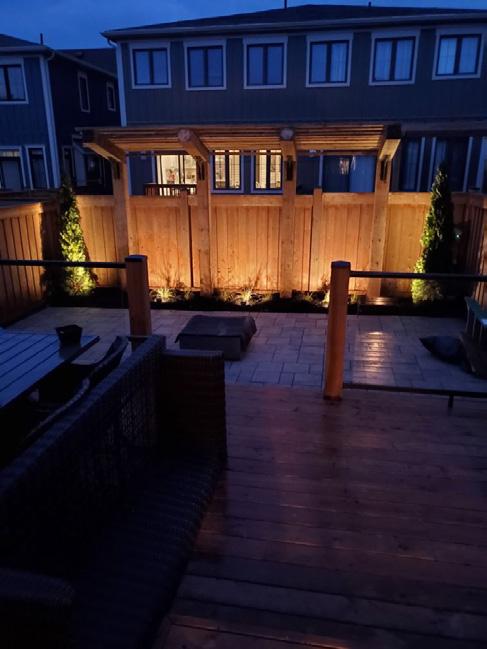

Blake describes the construction; “On the outside, the roof and walls are all clad in colour-impregnated steel that’s durable and maintenance-free, and at each outside entranceway, we embedded walk-off grates to remove snow and dirt from boots after a day of outdoor activity. On the inside, we went utilitarian, squeezing every inch of space we could.”
Touring the Jephcott home, simplicity and efficient use of space are evident everywhere. A unique stepladder imported from London, England serves as a design showpiece, while providing access to storage spaces. The modern kitchen features matte black countertops, sleek cabinetry and hidden appliances. Radiant heat concrete floors throughout the main level warm the entire two-storey home, augmented by a Scandinavian-style Stûv wood-burning fireplace in the living room.
The most striking feature of the interior is the treatment of the walls and ceilings—hardly an inch of drywall can be seen. Instead, clear, sanded plywood sheets sealed with a natural wax product imbue fascinating textures and warmth throughout the home.
“We tied in natural elements with antiques like Moroccan rugs, an antique dresser, vintage skis, and a Slim Aarons photo of a ski scene in Europe,” says Lindsay. “These were combined with a few personal touches like watercolour paintings and a cool-looking, moon-shaped paper lantern to give our home a feeling of warmth, comfort and coziness. And our strategically-placed windows provide natural light along with magnificent views to the natural surroundings. They are our art.” Overall, the style of the Jephcott home could be defined as “Hygge”, a word in Danish and Norwegian that describes “a mood of coziness and comfortable





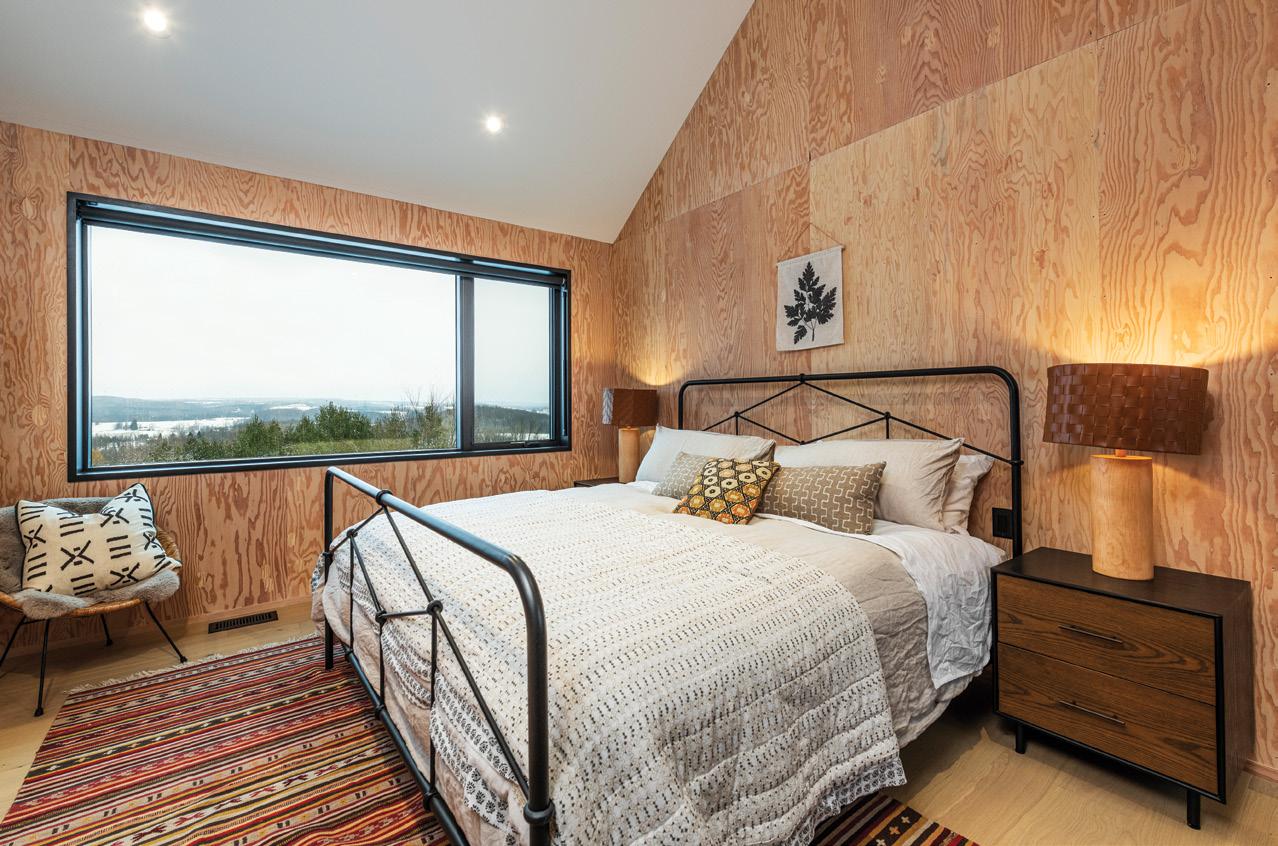


Classically-inspired corner columns are similar to the ones prominent at Monticello. The Jefferson office is reminiscent of the famous mansion Thomas Jefferson designed.



conviviality with feelings of wellness and contentment.”
The Jephcotts are loving their natural retreat, enjoying it on weekends and holidays for now, mainly because their four children are in school in Toronto. Down the road, they have big plans for their country property. The next project could be fixing up the immense barn near the house to either keep animals, rent or convert to an event space. “We have a large pond fed by an aquifer,
plenty of clean drinking water, lots of sugar maple trees, a sugar shack, and all the wonderful wild apples that we could ever eat. With our simple and comfortable home and lifestyle, I think we’re pretty much self-sufficient,” says Lindsay. Asked if her family would permanently relocate here from the city in the event of another pandemic or other catastrophe, she replies, “In a heartbeat.”
The Tale of Two Families continues on page 114
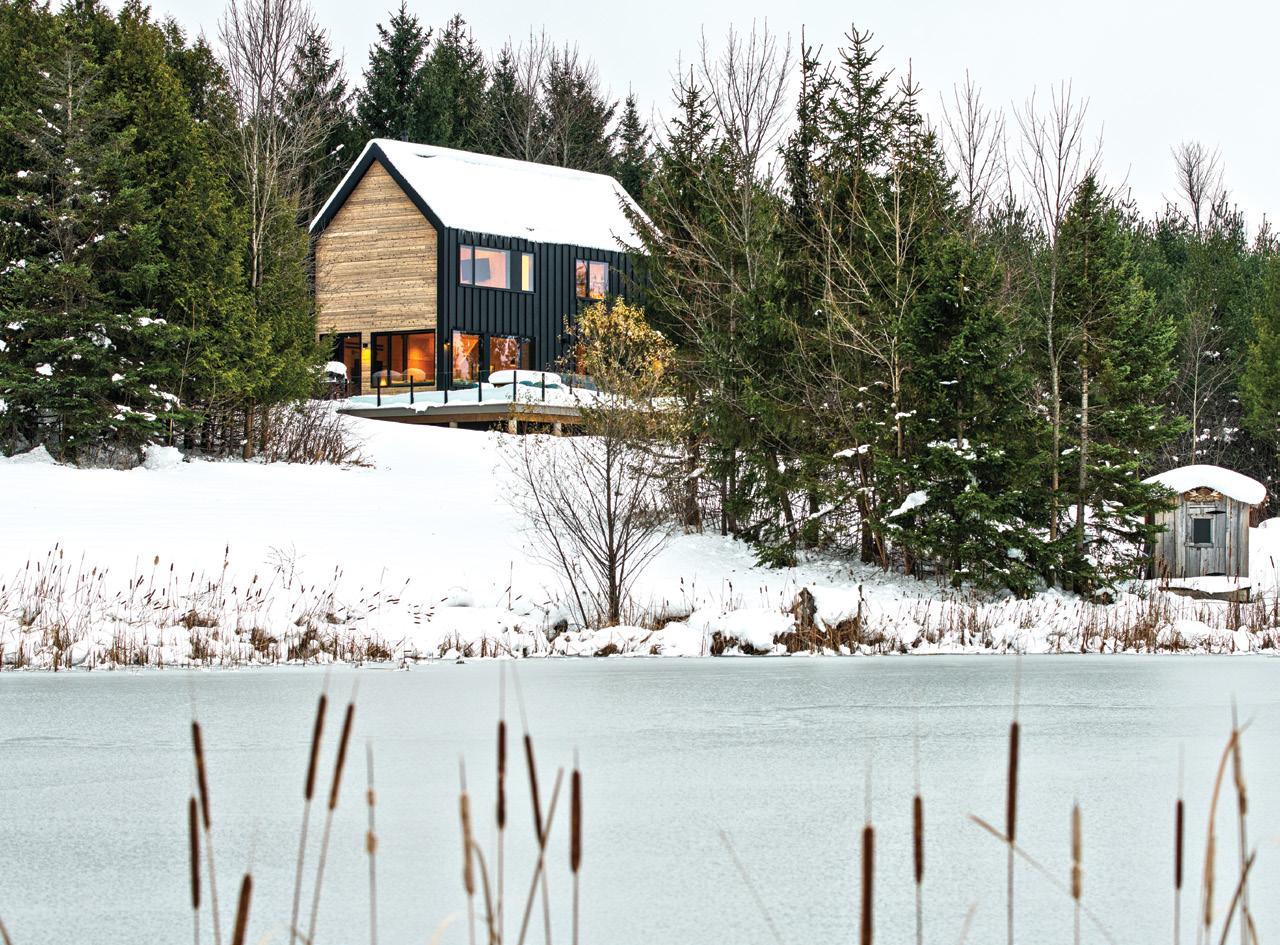
“We tied in natural elements with antiques like Moroccan rugs, an antique dresser, vintage skis, and a Slim Aarons photo of a ski scene in Europe. These were combined with a few personal touches like watercolour paintings and a cool-looking, moon-shaped paper lantern to give our home a feeling of warmth, comfort and coziness.”
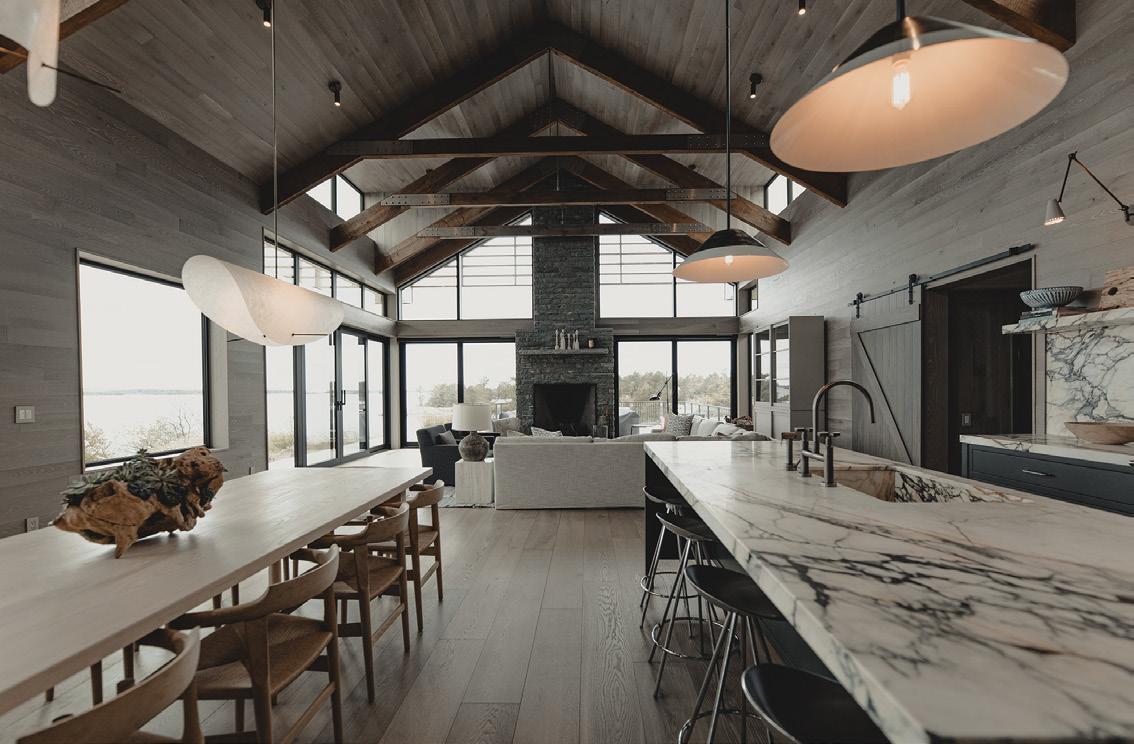



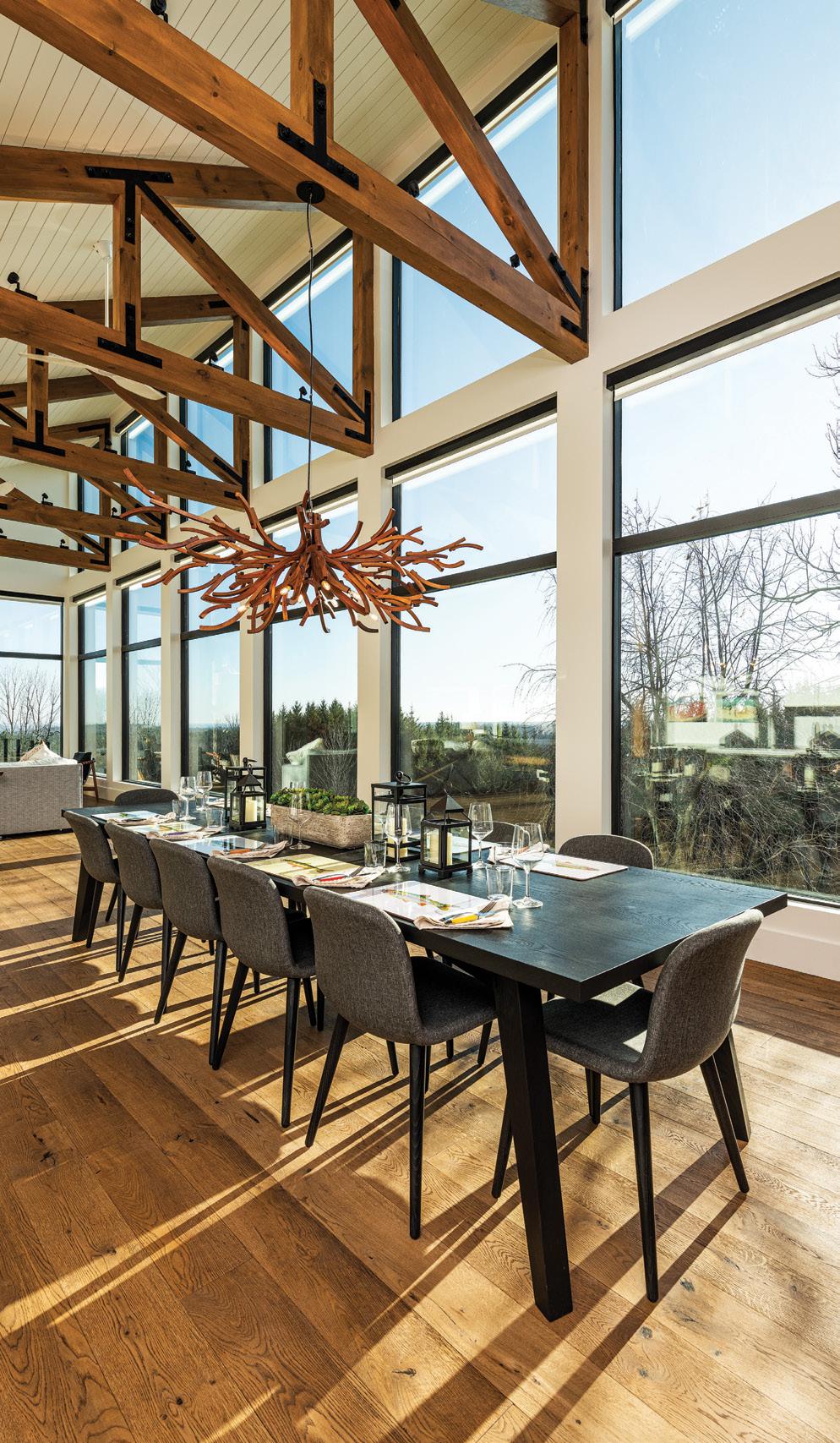

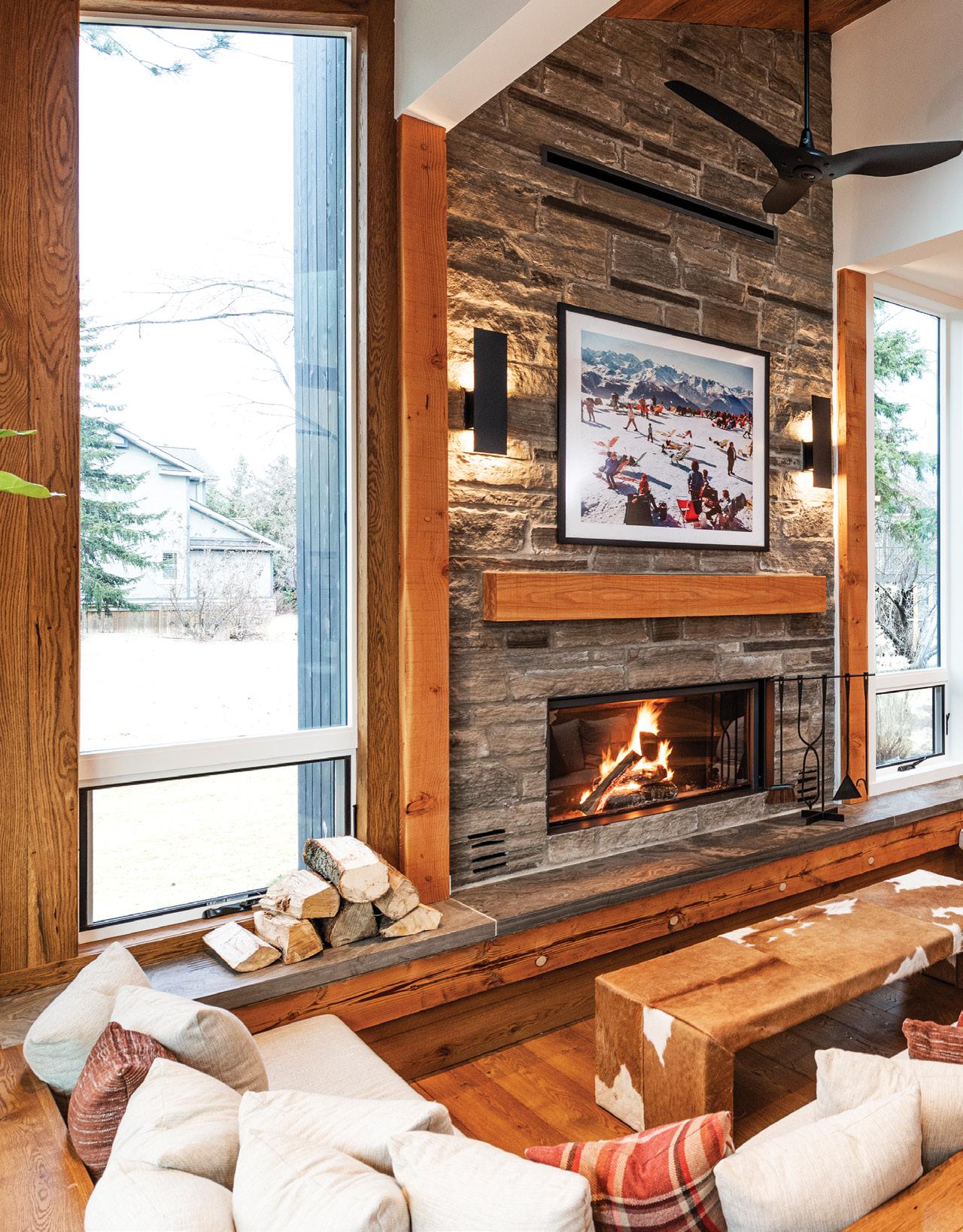
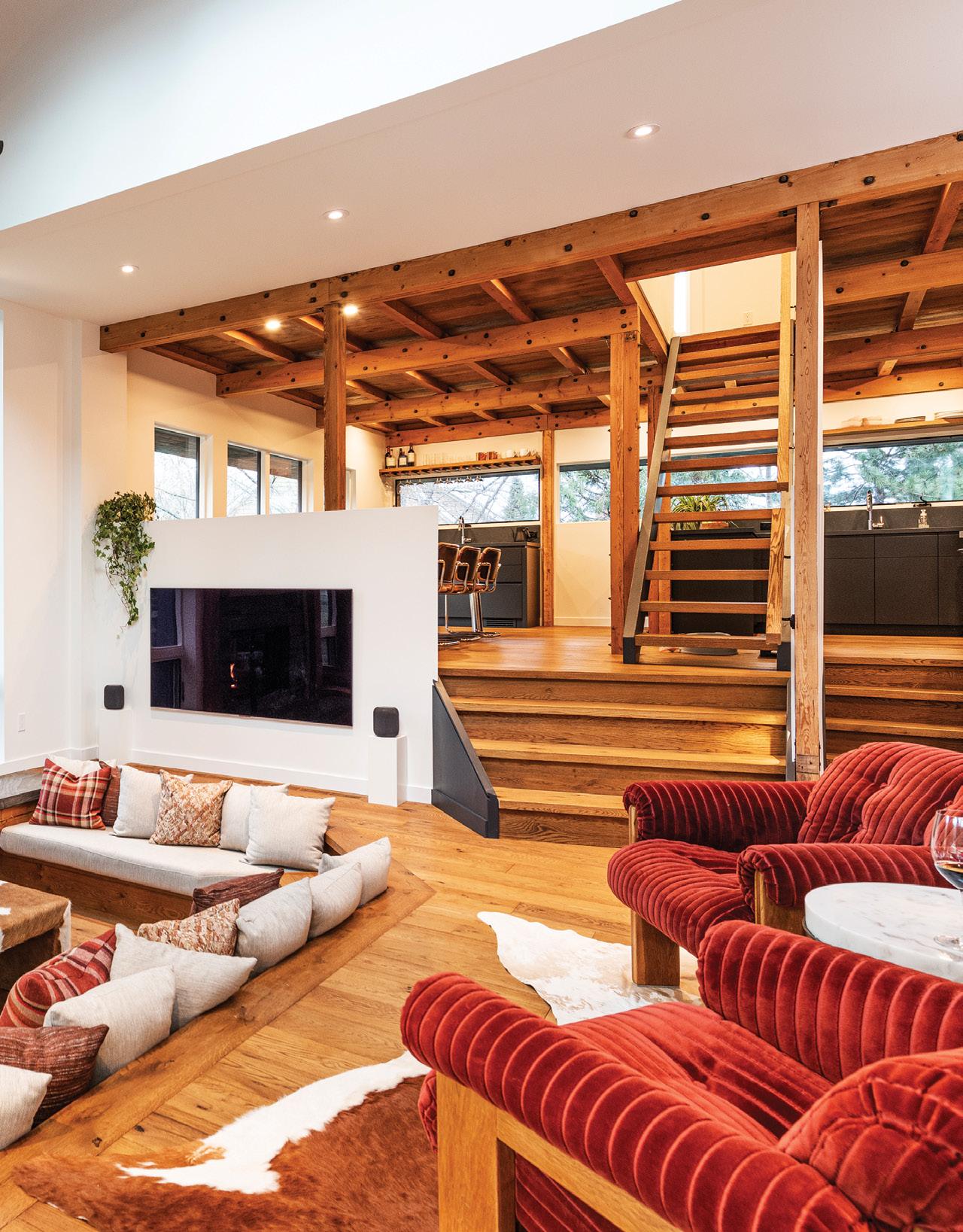 Styling by Farrow Arcaro Design
Styling by Farrow Arcaro Design
It was the very beginning of COVID-19. Emily and Sean Rucker, a successful professional couple living in Toronto, found themselves driving north to escape the city. Emily was pregnant, and they were towing a U-Haul filled with furniture and personal belongings from their tiny downtown condo, headed for the temporary sanctuary of the 1970s ski chalet at Blue Mountain they had purchased a couple of years earlier.
Prior to the pandemic, the Ruckers were happy living the professional downtown lifestyle, with good jobs and a condo near the Rogers Centre. In 2018, the Ruckers decided to cash in on what they thought were peak prices, sold their downtown condo and decided to rent.
“We were sitting on the proceeds of the condo sale and were thinking about getting back into the market at some point. But the prices kept going up and we were having a hard time justifying paying $700,000 for 500 square feet,” says Sean. Then, one day, driving back from a weekend cottage they were renting, Emily and Sean realized that, instead of buying a new home in the city,
they should buy a cottage, rent it to make some money, and use it themselves during the “shoulder” seasons.
Online searching revealed a unique 1970s chalet for sale, just steps away from Blue Mountain Resort. As it turns out, the home was built in 1978 for avid skier and local personality Joseph Balogh, who often entertained guests (including his good friend, the legendary Jozo Weider) with his famous après ski goulash parties.

The Ruckers were so passionate about the chalet and its provenance that, despite only an online description and a video of the property to go by, and two other bids in place, they put in an offer sight unseen. “We were immediately drawn to the character of the home, hence our hasty purchase,” Emily explains. “The multilevel layout, interesting angles, nooks, and many windows are what make it different.”
To the couple’s delight, their offer was accepted. Over the few next years, Emily and Sean rented the house in the summer and during ski season. But a recurring roof leak, unresolved despite numerous attempts to repair it, rendered the home unrentable.
And then the pandemic hit. “Emily was pregnant, we had just














signed a lease for a new apartment, and we were freaking out because we really didn’t want to be in an apartment building at the time,” says Sean. With both their offices closed and remote work the new reality, the Ruckers decided to move temporarily to the chalet instead, believing that the smalltown, lower density location would be a safer place in which to start their family.
And so, the Ruckers made their getaway to Blue Mountain. “We made the move temporarily to figure things out. But when Shopify, Emily’s company where she is a UX designer/manager, announced that they were going remote permanently, my business partner and I did the same,” says Sean, who co-owns a tech start-up that creates software for professional sports teams’ mobile applications.
With permanent remote work now possible, Emily and Sean decided to leave the city for good and make the chalet their home. Their daughter Zoey was born in Collingwood Hospital that year, and the couple realized that the old building needed some serious repair. “The place had a lot of problems,” says Sean. “Besides the biggest one, the leaking roof, it was poorly insulated and draughty. You could feel cold air when you put your hand close to the windows in the winter.”

The couple interviewed three local contractors for their renovation, and chose builder Blake Farrow. “We liked Blake and felt that he had a good understanding of what we wanted to do with the home—to keep much of the original character, but bring it up to modern standards,” says Sean. “And we also wanted to work with a designer, so when Blake introduced us to his s






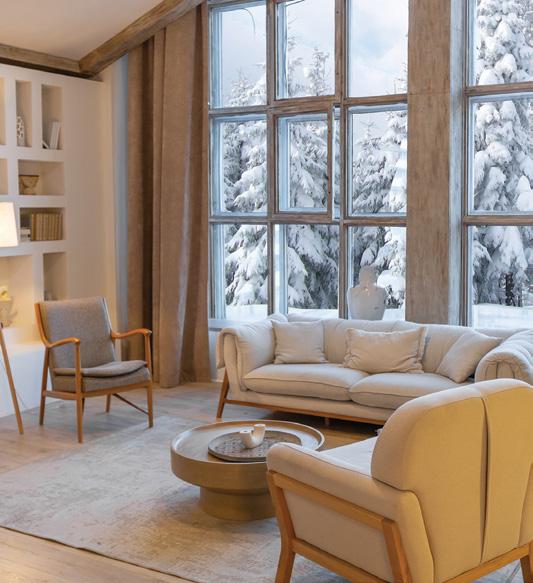


wife Marina, an interior designer with Farrow Arcaro Design in Collingwood, we knew we had found the perfect team to help us realize our vision.”
First things first, the leaking roof was finally repaired. The chalet’s centrepiece, a living area featuring a 1970s-style sunken living room, where family and friends would cozy up in front of a fire, was rebuilt while maintaining all of its original character. Stylish and energy-efficient Kolbe windows and locally-manufactured oak floors were installed here and throughout the home, and the sunken area was updated with new seating and a modern fireplace to replace a vintage one which Blake Farrow described as a “pizza oven”.
The basic structure and character of the rest of the chalet remained virtually intact, but reconfigured to modern standards, according to Blake Farrow. The building “envelope” was thoroughly sealed, insulation was added, and the complex existing spaces were reworked for better liveability and function. “Full credit to Sean and Emily for wanting to merge the edgy design features of the past with the conveniences of the new,” says Blake. “A fascinating amount of space was utilized. It was an interesting project, and we were all in.”

“We’re really into entertaining and wanted our home to be warm, inviting, unique, and functional. We did our best to accommodate big groups for dinners, sitting around the fire, and for sleepovers,” says Emily.
Throughout the home are examples of how the existing spaces were remodelled while preserving the feel of the old chalet: a large, refinished original dining room table; original wooden support beams doubled up to meet building code; a modern and functional kitchen with separate wet bar and walk-in pantry; ski equipment storage by the main entrance; a master and second bedroom (doubling as work stations) with “nook beds” under a skylight (for daughter Zoey, visiting kids and, occasionally, the family dog, Charley); in the lower level, a bedroom (with fireplace) resembling a modern hotel suite, and a gym and sauna.
With help from designer Marina Farrow, the Ruckers filled their renovated chalet with features that would pay homage to the original owner’s vision. Next to the sunken living room and fireplace stands a vintage two-seater chairlift (likely from the North chair lift at Blue), ready to elevate skiers up the






mountain for a day of fun.
“We bought the chalet fully furnished, complete with cutlery, plates and even a bowl of chips,” Emily recalls. “We knew that some of the solid wood furniture pieces were irreplaceable—midcentury design, over-sized and super comfortable. The opportunity to refinish them gave us a perfect way to marry the old and the new in a way that feels cohesive.”
Describing themselves as outdoor enthusiasts, Emily and Sean
are thoroughly enjoying their renovated chalet and all of the outdoor adventures available to them in Southern Georgian Bay.
“We worked with an incredible team of contractors and designers who helped us bring our home to its full potential. And now, we love being able to walk to the ski hill, shops, and restaurants, and maybe spend an afternoon exploring the towns nearby,” says Emily, whose parents, as well as several of the couple’s friends, have also moved up to region.

“We were immediately drawn to the character of the home. The multi-level layout, interesting angles, nooks, and many windows are what make it different.”





Whether you need a new concrete pool built in the backyard of your home, or you need to develop a larger commercial water oasis, we are the right fit for you. We will see you from design and build as you walk into your completed backyard oasis.
As one of the few luxury pool builders in Southern Ontario, with offices in Toronto & Thornbury, we specialize in projects both big and small, with a focus on the detail.



Looking to refresh your bedroom, add this elegant comforter set with tufted details for a modern look.

ARTHUR CASH & CARRY | 101 SMITH STREET | ARTHUR 519.848.6320 | ARTHURCASHANDCARRY.COM
We have a wide selection of table lamps, light fixtures and home accents, with an unrivaled selection and incredible pricing.

BAREBRICH | 920 2ND AVENUE EAST OWEN SOUND | 226.664.2273 BAREBIRCH.CA
WINTER
This authentic leather shearling sheepskin chair features small, natural nail head trim.

Woven in Belgium using traditional weaving techniques, these medium-weight throw blankets feature a soft boucle yarn on a cotton warp with a blanket-stitched finish. Soft to the touch and available in a variety of colours and patterns.
ASPEN & IVY | 322 KING STREET | UNIT 5 | BARRIE 705.721.8585 | ASPENANDIVY.CA
Keep your hands busy and warm this winter by learning to make yourself a cozy pair of traditional beaded leather mittens.

THE GEORGIAN BAY SCHOOL OF ARTS 938 2ND AVENUE EAST
OWEN SOUND WWW.GBARTS.CA
“Escarpment” by Everist Prokofiev, 60" x 48", acrylic on canvas.
MOUNTAINSIDE GALLERY | 705.444.2202 MOUNTAINSIDEGALLERYINC.COM

A true Canadian classic, the MacAusland woolen blankets have been made in Prince Edward Island for six generations. Made with 100% soft virgin wool, the blankets come in a variety of colours and are an essential for indoors or out by the fire.

LOVED YOU MADLY | 16 BRUCE STREET | THORNBURY 226.665.3533 | LOVEDYOUMADLY @ GMAIL.COM
This beautiful American Leather chair combines its relaxed silhouette with a natural walnut base. Works as a standalone piece in an entryway or corner reading nook, or paired with more structured décor in a living room. Featuring a premium foam seat for maximum comfort, and a durable yet elegant walnut frame, the chair is available in a wide selection of fabrics and leathers.
FARROW ARCARO DESIGN (FAD) | 51 HURONTARIO STREET COLLINGWOOD | 705.444.8330 | FARROWARCARODESIGN.CA
“Big Island Georgian Bay” by Shannon Craig Morphew, 40" x 60", oil on canvas.

CRAIG GALLERY | 4 NORTH SYKES STREET | MEAFORD 519.539.3671 | CRAIGGALLERY.CA
Imported from Sweden, Ojbro Vantfabrik mittens are designed by Ase Ojbro who takes her inspiration from traditional Swedish folklore. Ase and her husband Ted, produce a limited number of 100% organic merino wool mittens in their small family factory. Perfect for Canadian Winters! Make your home a cozy one with these sheepskin cushions all made sustainably in Denmark. The round cushions can be used as a cushion or a pouf.

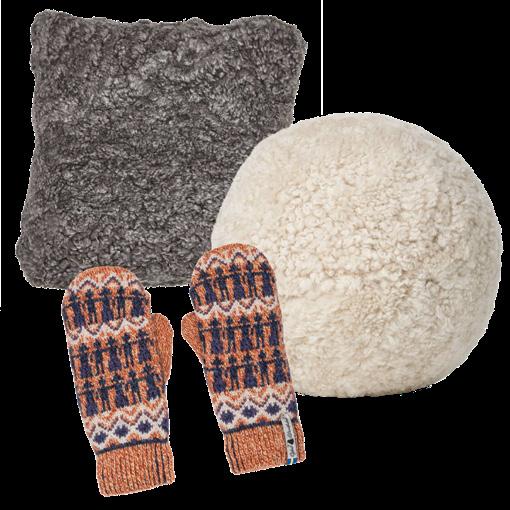
LAGOM 142 | 142 MILL STREET
LAGOM 172 | 172 MILL STREET
CREEMORE | 705.520.2172 | LAGOM142.COM
“Reaching” by Peter Dušek, limited edition, 60" x 60", 46" x 46", 38" x 38" and 21" x 17" pigment prints (photograph).

PETER DUŠEK GALLERY 151 MILL STREET
CREEMORE | 519.217.7770
PETERDUSEK.COM

“Blue Moon” by Lorne McDermott, 18" x 36".

LOFT GALLERY | 18 BRUCE STREET | THORNBURY 647.296.9797 | LOFTGALLERYART.COM

Beat winter with this four-speed Husqvarna ST124 Walk Behind snow blower.

ROBERT’S FARM EQUIPMENT 014945 BRUCE COUNTY RD 10 CHESLEY | 519.363.3192 ROBERTSFARM.COM
This solid maple Metro bed is 100% Canadian made. With straight lines and a wide choice of colours it will be sure to suit almost any home.

COUNTRY CHARM MENNONITE FURNITURE 317680 HWY 6&10 | OWEN SOUND | (JUST SOUTH OF ROCKFORD) 519.376.4434 | CCHARM.COM
This Vogt Linz Kitchen Faucet is built with solid brass construction and features a dual spray 360-degree swivel spout and two stream function options. Available in chrome, brushed nickel and matte black.

GEORGIAN DESIGN CENTRE 84 HIGH STREET | COLLINGWOOD 705.444.2100
GEORGIANDESIGNCENTRE.CA
True custom design profiles and colours, each cabinet door is built to accentuate your new cabinetry and make the most of your kitchen, bath, or closet space.
EXQUISITE CUSTOM CABINETS 1980 20TH STREET EAST | OWEN SOUND 519.370.0808 | EXQUISITE-CABINETS.COM

At Vibrant Escape, we believe that a backyard should be more than just a piece of property to maintain. It should be a destination.
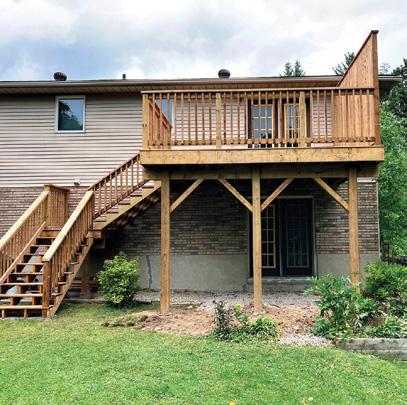























18 karat yellow gold necklace, bracelet and earrings by Marco Bicego. The Paradise Collection features hand engraved gold beads, blue topaz and mixed gemstones. All from DC Taylor Jewellers, Downtown Collingwood.
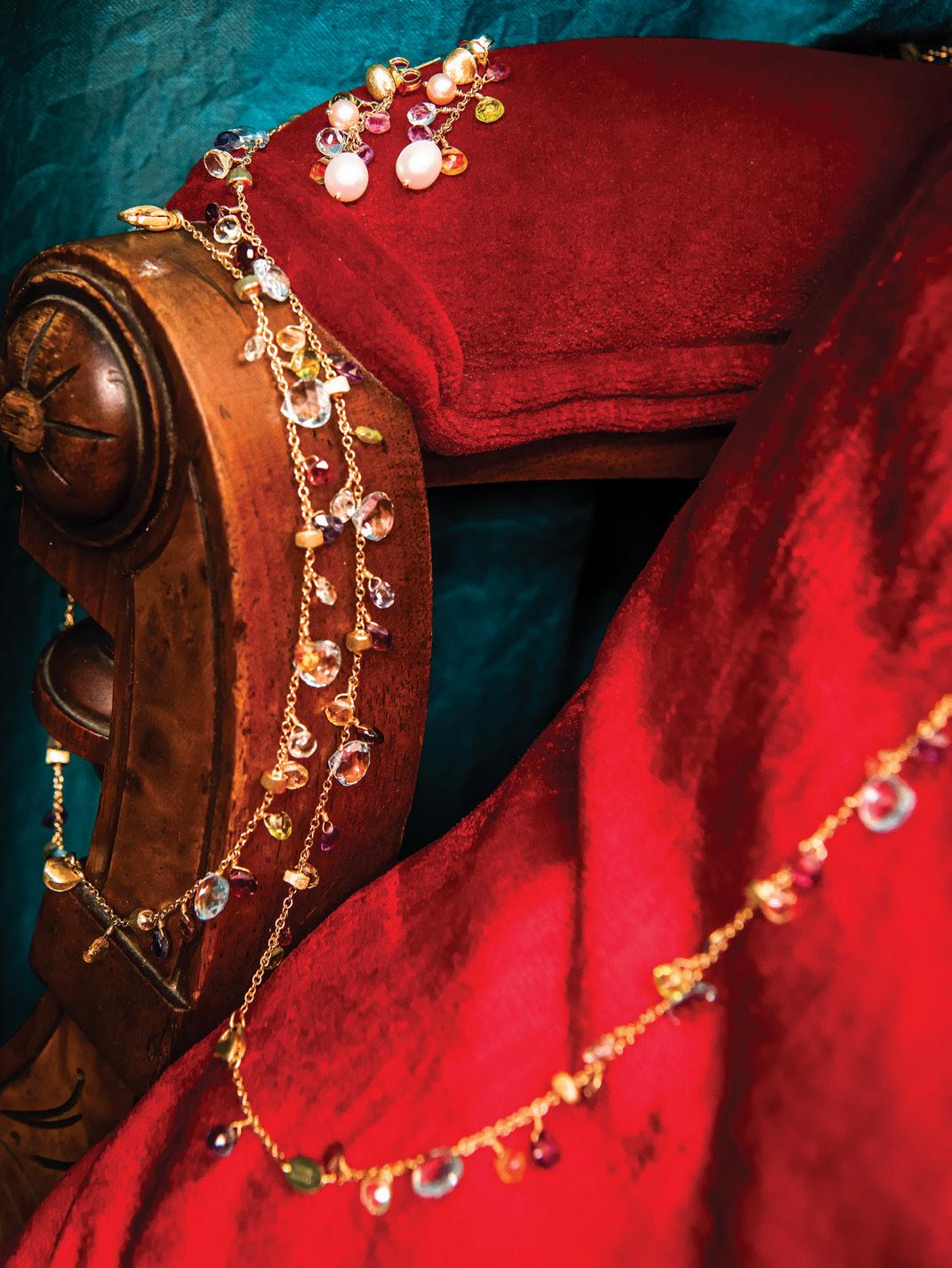
Hair & Makeup by Katie Ballantyne
Check-in with style in stunning looks from the area’s best independent retailers. Photographed at Collingwood’s newest boutique hotel, 11 Rooms.

Clothing from Brabary, Downtown Collingwood.
FRANCINE ADDISON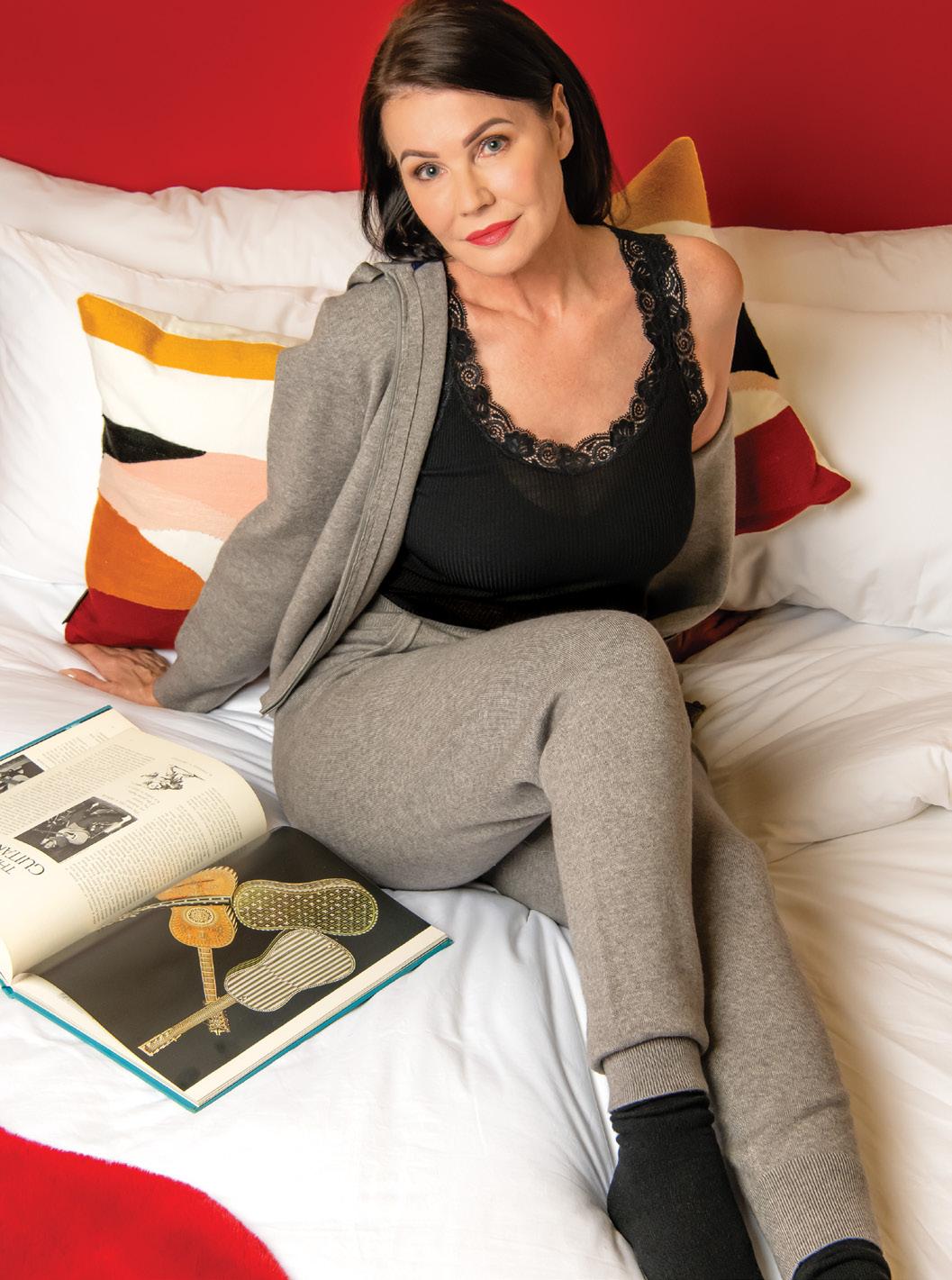

A Collingwood resident, Francine loves hiking the trails around her home. She works at Living Water Resort and in her downtime, she enjoys spending time with family and friends.
Clothing, accessories and footwear from Tigs, Thornbury.

After living for many years in Toronto, Brittany moved back to her family’s apple farm in Clarksburg. She looks forward to planting her own roots, here at home.



















Boon Bakery is an artisanal, gluten, and dairy free bakery in Owen Sound’s River District. After learning that she was gluten intolerant, owner Maegan Cookson saw a gap in the market; “Fresh bread is hard to find when you are gluten free,” says Maegan. “When my son and I encountered health issues and discovered that eating gluten and dairy was unadvisable for us, it was a natural progression to create recipes that worked for us and to share them with others. I turned my home kitchen into a test kitchen and in very short order was making real bread! It is possible. Gluten free does not have to mean a life without flavourful and healthful bread.”
Boon Bakery got its start at the Owen Sound Farmers Market in October 2020 and opened the brick and mortar location across from city hall in October 2021. “I wanted to add to the fabric of Owen
Sound’s River District and fill a great need in the community. In conceiving the bakery, I chose the name ‘Boon’ because it means, ‘a helpful or beneficial thing’ and that’s what we hope we are achieving.”
Maegan and her team offer a wide variety of delicious baked goods including desserts—they also have gluten free, dairy free and vegan grocery items, grab-andgo meals, coffee or cold drinks. “Having dietary restrictions can be challenging and we aim to provide delicious options for anyone who is avoiding gluten or dairy,” says Maegan. “We have many customers who enjoy our products regardless of being free from gluten and dairy. We like to think our products are for everyone. Gone are the days of cardboard bread and gritty cookies! We are making bread and baked goods that rival their wheat counterparts. In fact, because we have so many different flours to choose from, we would argue, they are often even better! Just because you have
dietary restrictions doesn’t mean you don’t deserve scrumptious treats and bread.”
Small batch, from scratch breads as well as fresh from the oven sweets and treats are produced daily at Boon. And because everything in their grocery section is gluten and dairy free too, Boon Bakery is your one-stop shop.
“I hope my passion for whole food shines through in my baking,” says Maegan. “I take pride in using my homegrown, gluten free, wild sourdough starter to make my breads with. I recognize that food is as good as the quality of ingredients and the amount of love you put into it.” Check their website and social media channels for weekly fresh bread schedules. “We have many different flavours of muffins, cupcakes, and seasonal offerings, so the best way to stay up-to-date is to phone the bakery.” 813 2nd Ave E, Owen Sound 519-416-7000 boonbakery.ca
Owner Rick Sadler and the team at Xtreme Property Developments Inc. are known for designing, building and managing executive custom homes (and renovations) in Grey, Bruce and Simcoe counties. So, creating a custom cabinet manufacturing facility in Collingwood was a natural progression— Xtreme Kitchens and Closets was created. With state-of-the-art custom machinery and an in-house paint booth, Xtreme Kitchens and Closets produce precision quality cabinetry and mill working locally, at affordable prices. “We are very pleased to be able to make entire kitchens in our production center every week,” explains Rick. “We don’t outsource to big city suppliers with long wait times. We control the entire process from design, to build, to installation.”
The team at Xtreme Kitchens and Closets create breathtaking, modern custom kitchens, closets and vanity designs. They also offer no-fuss installation as well as renovation services, which include full basement renovations, bathrooms, kitchen remodels, bedrooms, mudrooms, closets, flooring and much more.

“I’m incredibly passionate about creating dream projects for clients,” explains Rick. “We specialize in modern design cabinetry and maintain an innovative approach. It ensures products get built with precision and sold transparently at an affordable price. I work with integrity, and as an individual, I believe what sets me apart from others is my compassion. I also have a strong work ethic, and I’m committed to problem solving and multi-tasking to meet the unique needs of my customers. As a result, it’s immensely satisfying to complete projects successfully and see the happy smiles on my customers’ faces, which
makes the long hours worthwhile. It’s also rewarding to empower staff and make a positive difference in their lives by offering constant support and mentoring.”
A full-service renovation and custom cabinetry company, Rick explains: “We have created a very popular contractor, developer and designer program that caters to multiple resident construction. Our clients are varied, from single residence projects to multiple room millwork projects including kitchens, pantries, closets, fireplace cabinets, walk-in closets and custom millwork throughout homes.”
These experienced cabinetmakers and designers strive for excellence. When sourcing a new custom kitchen, closet, vanity, or another home renovation project, call the Xtreme Kitchens and Closets sales team to set up an appointment.
10 Greco Court, Unit 1, Collingwood xtremekitchensandclosets.ca 705-445-8800
life in Collingwood.”
Your home is one of the biggest purchases of your life, so it makes sense to customize it to your wants and needs. Scott Fleming and the team at JA Custom Homes team are here to help. In their third year of business, JA Custom Homes has recently relocated to Collingwood and opened a satellite office in Thornbury.
“My wife’s family were long-time members at The Peaks,” explains Scott. “For years we’ve been enjoying all the great things Collingwood is known for. It was natural that my wife wanted to provide the same upbringing for our young family so we packed up our family and brought JA Custom Homes to
With high-end planning and design services, Scott and his team can map the perfect space. “We pride ourselves on delivering the highest quality product and putting our clients as the focus of everything we do. That means helping you turning your home vision into a beautiful reality.” JA Custom Homes has a fully stacked team with each member having an individual speciality to nail down every aspect exactly as you picture it. Not looking to build an entire house? Don’t worry, they’ll also help turn your already existing spaces into ones you can fall in love with again.
Supporting local is always topof-mind for JA Customs Homes. “All the trades we work with are locally owned businesses which is extremely important for us to keep the jobs in this area.”
Catering to all types of builds, JA Custom Homes has 10 fulltime employees with

various custom trades in-house, including framing, concrete, ICF and newly added foundations/footings—this helps the company keep costs down for clients as well as managing timelines efficiently.
“I have always been in renovations and additions,” explains Scott. “The passion for taking a run-down building and making it beautiful—out of blood, sweat and tears—has taken me down a long and winding road to now—having a successful, custom home building business in the best place to live and raise a family. ‘Your home, built your way’ is our motto. I like to work with great customers more than the size or complexity of the project. This is why we have so many diverse types of builds.” Unit 2, 2682 Concession 6 North, Collingwood 705-351-1047 jacustomhomes.ca
“We are a sophisticated custom pool builder that provides a full-service experience,” says G3 Pool and Spa owner Bill Yoder. With 50 years of experience in transforming backyards Bill is proud to announce the opening of their new offices in the Collingwood and Blue Mountains area. “We’ll install, repair or renovate any type of pool—concrete, vinyl, fiberglass and steel pools. We will see you through from the beginning stages of planning to fruition when you walk into your completed backyard oasis!”
Offering a wide range of services to both builders and homeowners, the experts at G3 Pool and Spa pride themselves in offering quality work, which is based in honesty, transparency and collaboration.
“Our commitment to customer satisfaction stems from detailed planning,” says Bill. “Our leadership provides clear, concise communication and project management leading to quality built pools and spas. As third generation pool builders, we’re proud to say we’ve been at the forefront of this ever-changing industry for almost five decades.
Our experience gives us a competitive advantage. Building refinements which we’ve developed, allow us to build the highest quality pools and spas for less money. What does that mean for our customers? Unparalleled quality, unmatched price and the best customer service in the business.”
From designing to building, G3 Pool and Spa offers inhouse landscaping/ hardscaping and employs a full design and consulting team. They also provide weekly service and delivery of pool chemicals. “Many of our established client base have homes in the Collingwood and Blue

Mountains area and have repeatedly asked for our services. Our area of expertise is concrete pools and water features. Working both with homeowners and on commercial projects, we are looking to employ the local community to assist us in growing our established business.”
Pools and spas are meant to be enjoyed for years, which is why the team at G3 Pool and Spa focuses on the design and construction ensuring that each client receives a high-quality pool or spa that will last. “We believe in a ‘win/win’ outcome, always. We approach every one of our clients’ backyards as if it were our own. We will always stay on top of the pulse of our industry to provide the best possible product for our customer. We will see you from design and build as you walk into your completed backyard oasis.” 124 West Ridge Drive, Thornbury 705-440-7458 g3poolandspa.ca

Where to begin—the pandemic has thrown us a curveball over the last few years, affecting all aspects of our lives. As we’ve adjusted and continue to adjust to changes, it sometimes shocks us to see how far we’ve come over such a short period of time. The housing market is no different. Clients often ask whether this is the “right” time to buy or sell, and the
answer is; it depends. If you are a buyer and have access to either cash or borrowing, there is a healthy amount of inventory and an expectation from sellers that they will have to negotiate. If you are a seller, you should be prepared for your home to sit on the market for several months. Your home should be ready for sale, staged if needed, have a good marketing plan, and a realistic price. When pricing your home, it is important you aren’t looking at comparables from early 2022 as a basis for your pricing strategy. Take the advice of a local REALTOR®
We’ve seen the market take some sharp turns over the past two years. First, we experienced record-low inventories and record-high home prices in 2021, resulting in a strong seller’s market. We

now see steady activity from both buyers and sellers, shifting us to a more balanced market. Naturally, with the Bank of Canada’s interest rate hikes, housing activity and prices eased up. It’s forecasted that interest rates will continue to be a hot topic through 2023 before settling back down in 2024.

Let’s dive into the data for the Lakelands West area, which consists of The Blue Mountains, Clearview, Collingwood, Grey Highlands, Meaford, and Wasaga Beach.
At the beginning of Q1 in 2022, we start to see an uptick in new listings, with 157 new listings in January and 326 new listings at the start of Q4. At the end of February 2022, we saw the invasion of Ukraine by Russia, which was followed in s
We are no longer in a seller’s market as prices drop and there’s no shortage of inventory.




early March 2022 with the first of a series of interest rate rises. Both buyers and sellers were staring to get a little nervous.
With two further interest rate rises (one in April and another in early June), it appeared that the May long weekend was the turning point for multiple offers and rapid sales. Since then, we have seen three further interest rate rises, bringing us to the current 4.25% Target Overnight Rate. Needless to say, this has caused concern from buyers who may now be struggling to get mortgage pre-approvals at the amounts previously achievable. The result is fewer qualified buyers. This has been compounded by the increasing rate of inflation, and therefore affordability.
With more inventory hitting the market, we started to see a shift in home prices. The median price* made a steady decline from $855,000 in January 2022 to $700,00 in October 2022. As more homes entered the market, the demand adjusted, and we started to transition to a more balanced market. But, with a more balanced market, will prices continue to fall?

Economic theory would say no—however, if we move from a balanced market to a buyer’s market, we may see further
reductions. Remember, when we discuss price reductions they are only applicable to 2022 from Q2 onwards. When discussing pre-pandemic pricing to today, there has been a significant increase. For instance, the median price year-to-date in October 2022 was $825,000, which is 77.4% higher compared to the October 2019 year-to-date median price.
An important piece of data to focus on is how long homes sit on the market as this directly impacts whether we’re in a sellers or buyer’s market. The sweet spot is somewhere between four and six and a half months. In Q1 2022 we had one months’ worth of inventory, but this moved to almost five months of inventory at the end of Q2 2022. As we enter Q4 2022, we’re at almost six months’ worth of inventory.
We’ve seen some significant shifts in the market due to the pandemic and the Bank of Canada’s latest efforts to correct the market. That said, the lack of housing supply has been at the core of our housing crisis, even before the pandemic shifted our focus.
The demand for homes cannot keep up with our current supply, and housing affordability directly impacts and adds to this crisis. Ontario must build 1.5 million
homes in order to improve affordability and solve the supply shortage in the province. Who is affected most—those looking to get into the market. We have an entire generation that can no longer qualify for a mortgage. Their dream of becoming a homeowner is drifting further and further away. The Ontario Real Estate Association (OREA) has been advocating for change to ensure all Ontarians have a fair shot at the Canadian dream of home ownership.
With all that being said, it remains true that Real Estate is the best investment you can make. More than ever, it’s crucial to use a local REALTOR® as they have the local knowledge, market insight, and community network to confidently buy and sell a home in the region. This directly impacts how our communities grow and evolve, as an in-the-know REALTOR® professional addresses important aspects when it comes to the home buying or selling journey. This includes investment properties, waterfront lots, Municipal regulations, zoning laws, and so on. E
* Median price is the price where half are higher and the other half are lower, representing the price in the middle of the range. Preferred, as it has the advantage of not being skewed by outlier prices.














































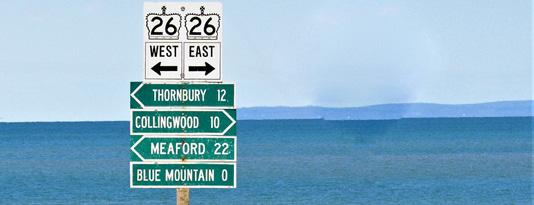




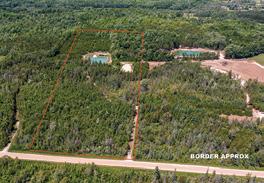







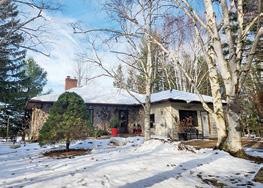
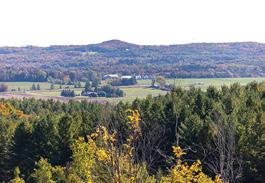


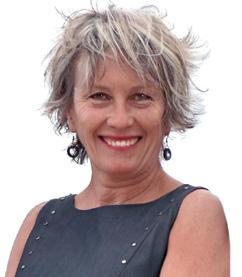


COLLINGWOOD, ON: 705-445-5520 | THORNBURY, ON: 519-599-2136 MEAFORD, ON: 519- 538-5755 | CREEMORE, ON: 705.881.9005 WASAGA BEACH, ON: 705-429-4800 | STAYNER, ON: 705.428.2800 CRAIGLEITH, ON: 705.445.7799









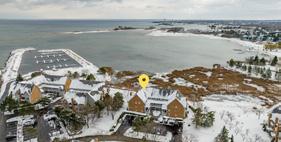



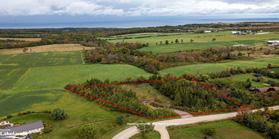


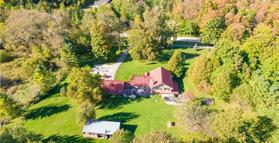







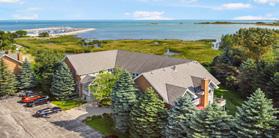









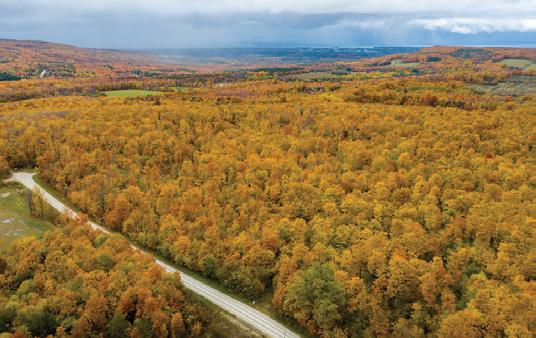






“I shot this from a bird’s eye view using my DJI Mini Pro 3 drone. The composition magically draws the viewer into the photo using the leading lines of the road and the Creemore bridge on Collingwood Street. Drone photography can be quite tricky at times because it’s more about finding the right composition and less about flying to the maximum altitude.”

Robert Burnaccioni is a mixed-media artist and photographer based in Clearview township. He is best known for striking landscapes. “I’m passionate about photography and capturing high quality imagery. I’ve shot professionally for many years, concentrating on dance, action and sports photography,” says Robert. “Lately I have been focusing on capturing beautiful local landscape scenery and sharing them with the community.” Follow Robert @robburnsphotography
Tag @escarpmentmagazine or #escarpmentmagazine on Instagram or Facebook for a chance to be featured in Aftershot. Your image will appear in an upcoming issue of Escarpment, plus you’ll also receive a $200 gift certificate to a local restaurant.
Annan, ON Presented at $3,950,000 Elegant 3.6 acre estate on 300+ feet of waterfront.
Meaford, ON Presented at $1,950,000 Modern four-season lake house on Georgian Bay.

West Grey, ON Presented at $2,295,000 Gorgeous timber-frame home with a pond on 4.6 acres.
Georgian Bluffs, ON Presented at $1,325,000 Custom bungalow with sophisticated touches steps from the Bay.


At the McGREGOR HAHNE GROUP, we have a reputation for delivering exceptional service and possessing unrivalled expertise of the Grey Bruce and the Southern Georgian Bay real estate markets. We personally have our hands on every aspect of your purchase or sale. We take care of the details so that you can make memories in the home you love.
